Review of the CWWK x86 P6 Mini SSD NAS Review
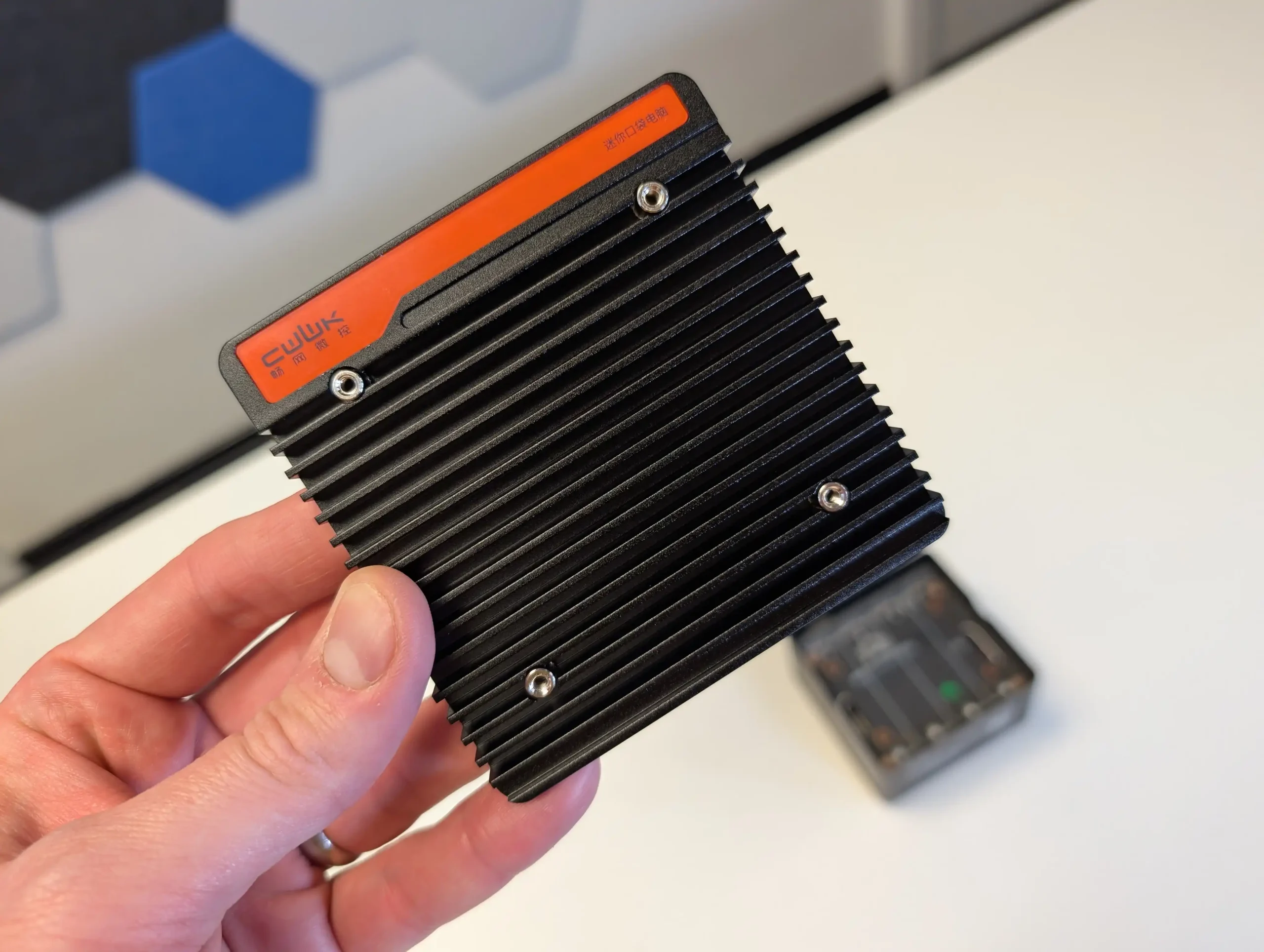
The CWWK x86 P6 Pocket SSD NAS is a compact, all-flash server aimed at home lab enthusiasts and small businesses seeking high-speed storage in a small form factor. It features four M.2 NVMe slots, dual 2.5GbE ports, and support for up to 48GB DDR5 memory, offering impressive capabilities for its size. Available in two configurations, the quad-core Intel N150 model and the octa-core Intel N355 model, it aims to balance affordability and performance. This review covers the design, hardware, storage, performance tests, and overall value of the N355 model. Compact and highly portable, the P6 is marketed toward users who need a small but capable server for virtualization, containerized apps, and media streaming. With support for up to four M.2 NVMe drives, it caters to users focused on high-speed, flash-based storage rather than traditional hard drives. However, its PCIe 3.0 x1 lanes per M.2 slot and lack of 10GbE raise questions about its potential bottlenecks.
The P6 is priced competitively at $195 for the N150 version and $315 for the N355 version, placing it in a niche between DIY NAS solutions and more expensive pre-built systems. Despite its compact size, it promises a multi-core processor, virtualization support, and dual 2.5GbE connectivity, making it appealing to users with small-scale but demanding workloads. However, users should be prepared for some limitations typical of compact systems, such as limited expandability and port options. Let’s discuss the P6.
| Component | Details |
|---|---|
| Processor (SoC) | Intel Twin Lake SoC (Two Options): – Intel N150: Quad-core, up to 3.6 GHz (Turbo), 6MB cache, 24EU Intel UHD graphics (1.0 GHz), 6W TDP – Intel N355: Octa-core, up to 3.9 GHz (Turbo), 6MB cache, 32EU Intel UHD graphics (1.35 GHz), 15W TDP |
| Memory | 1x SO-DIMM DDR5 4800 MHz (up to 48GB, Non-ECC) |
| Storage Slots | 4x M.2 M-Key 2280 NVMe SSD (PCIe 3.0 x1 per slot) |
| Additional Expansion | 1x M.2 E-Key 2230 slot for Wi-Fi 6/7 modules |
| SATA Support | 2x JFPC1 Ribbon Cable Connector (for SATA drives via adapter) |
| Video Output | 2x HDMI 2.0 (4K@60Hz) |
| Networking | 2x 2.5GbE RJ45 (Intel i226V controllers) |
| USB Ports | 2x USB 3.2 Gen 2 (10 Gbps) |
| Power Supply | 12V/5A via 5.5/2.5mm Barrel Connector (60W adapter included) |
| BIOS/UEFI Features | AMI BIOS/UEFI with Auto Power On, Wake-on-LAN (WoL), PXE Boot |
| Cooling | Integrated aluminum heat sink with base-level fan; Optional external top-mounted fan (USB-powered) |
| Chassis Material | Aluminum Alloy (entire enclosure) |
| Dimensions | 100 x 100 x 58.5 mm |
| Weight | Approx. 1.2 kg |
| Operating Temperature | -10°C to 75°C |
| Humidity Range | 10%–90% RH (non-condensing) |
| Where to Buy? |
CWWK x86 P6 N355 SSD NAS Review – Quick Conclusion
he CWWK x86 P6 Pocket SSD NAS offers a compact and capable option for users seeking a small-scale, flash-based server with support for multiple VMs, containers, and media streaming. The Intel N355 model performs well under load, handling three VMs simultaneously while maintaining reasonable power consumption of 34–35W. SSD speeds were solid for a PCIe 3.0 x1 setup, reaching around 780 MB/s read and 690 MB/s write per drive, though aggregate speeds across four drives were limited to 450–520 MB/s. Cooling is generally effective, with CPU temperatures peaking at 40°C, but NVMe SSDs required improved thermal pads to keep below 55°C under load. Noise levels remained moderate, between 35–38 dBA depending on fan usage. The inclusion of SATA support via JFPC1 ribbon cables, while unconventional, offers an additional expansion route, though BIOS adjustments may be needed for full compatibility. Dual 2.5GbE ports support link aggregation but limit network throughput compared to 10GbE options, which can only be added via an M.2 to 10GbE adapter, sacrificing a storage slot. The two USB ports are restrictive for those needing additional connectivity. Overall, the P6 delivers good multi-purpose performance in a compact form factor, but its PCIe lane limitations, limited USB ports, and barrel power input may be drawbacks for some users. It is a suitable choice for those seeking a small, efficient, and configurable NAS, provided they understand its hardware constraints.
Where to Buy a Product





![]()
![]()

VISIT RETAILER ➤






![]()
![]()

VISIT RETAILER ➤






![]()
![]()

VISIT RETAILER ➤






![]()
![]()

VISIT RETAILER ➤
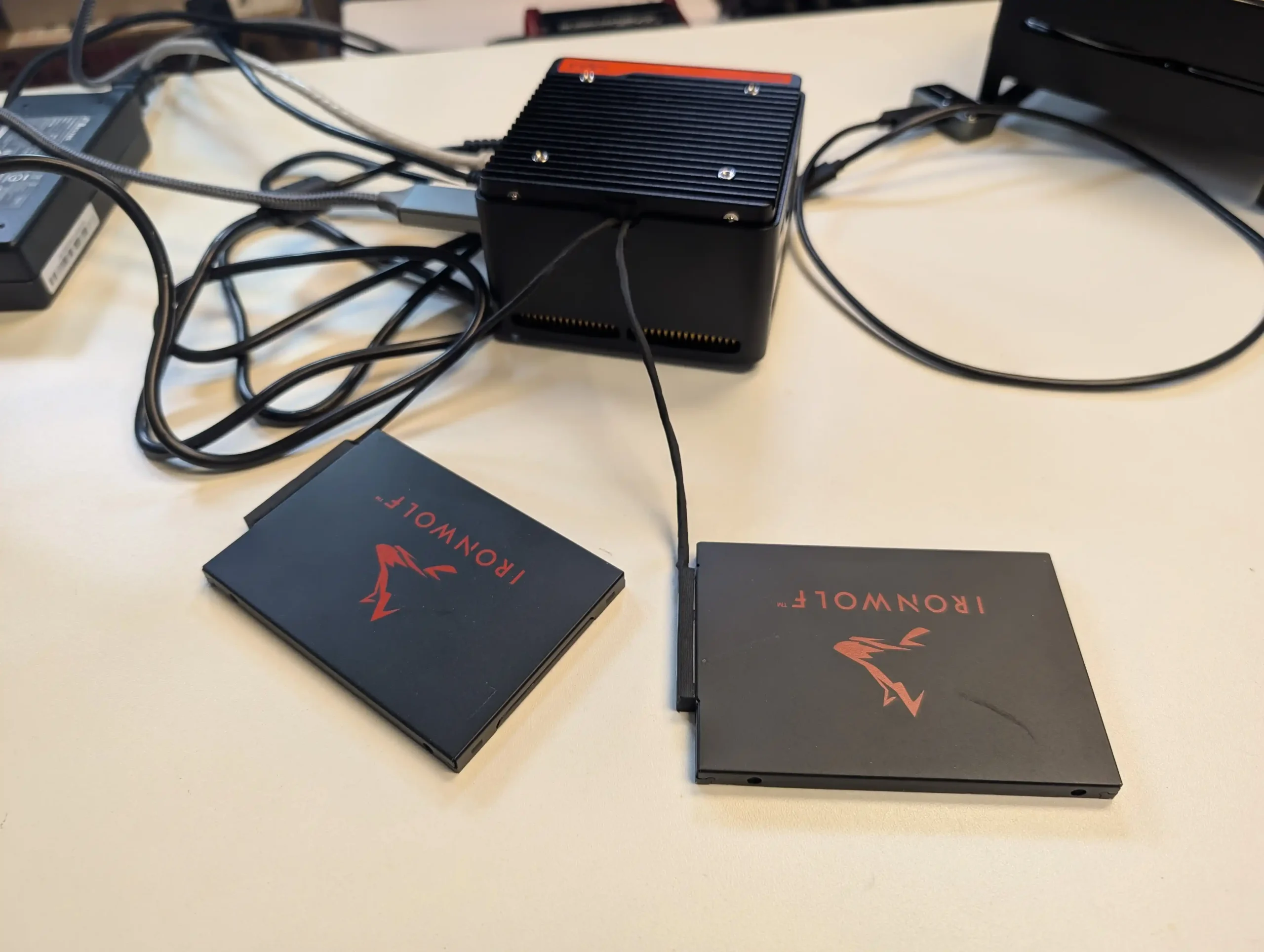
CWWK x86 P6 NAS Review – Design
The CWWK P6 is remarkably compact, measuring 100 x 100 x 58.5 mm, and built with an all-aluminum alloy chassis, which doubles as a heat sink. Weighing approximately 1.2 kg, the unit has a solid, durable feel.
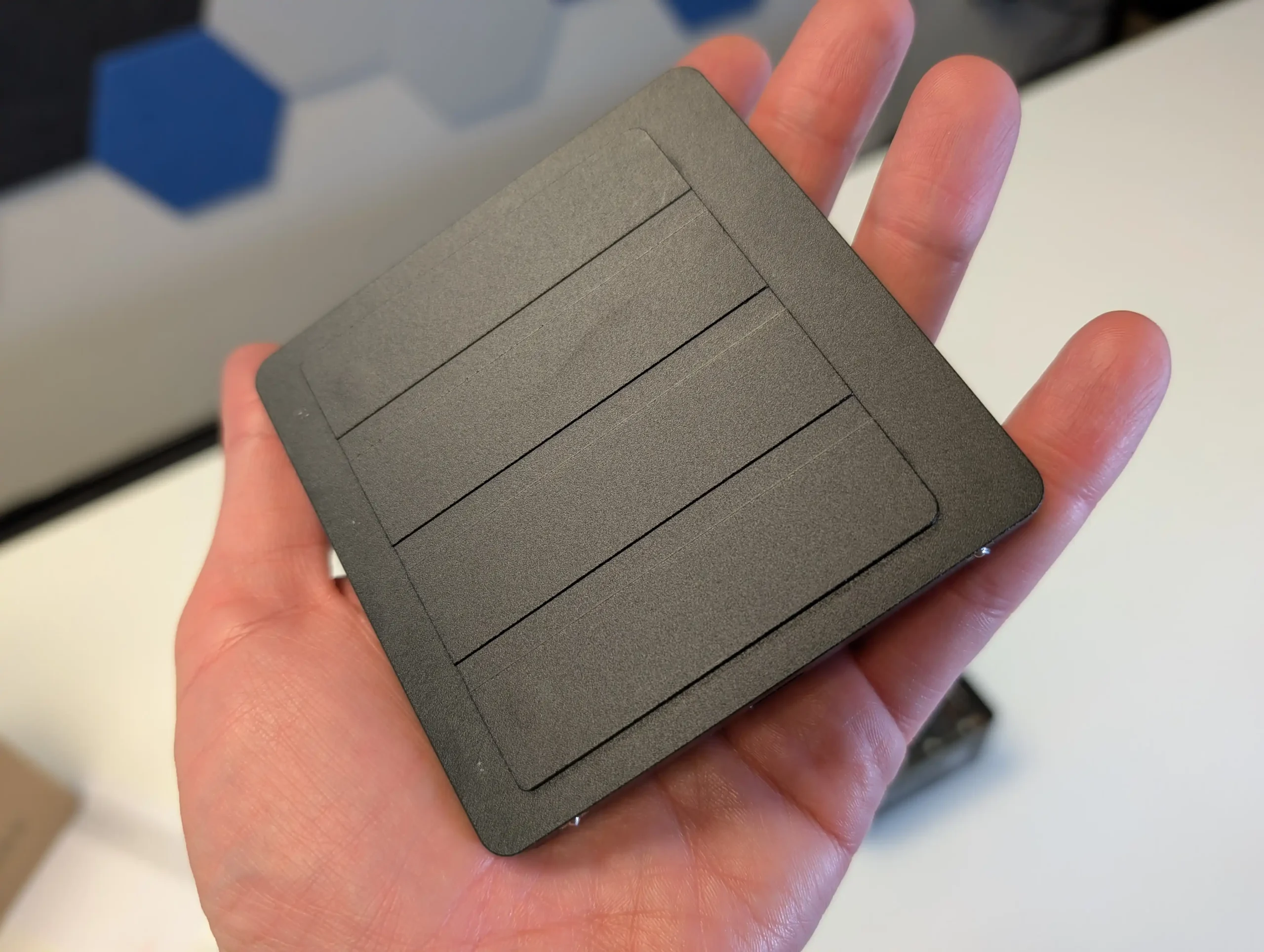
The top panel functions as a large heat sink for the SSDs, while the bottom panel houses a CPU fan and aluminum heat sink.

The cooling system is effective but relies on passive dissipation for the SSDs unless the optional external fan, included in the package, is attached via USB.

The power input uses a 12V/5A barrel connector, which is disappointing for users expecting USB-C. Given the small size and relatively low power draw, USB-C with Power Delivery (PD) could have been a modern and convenient solution.
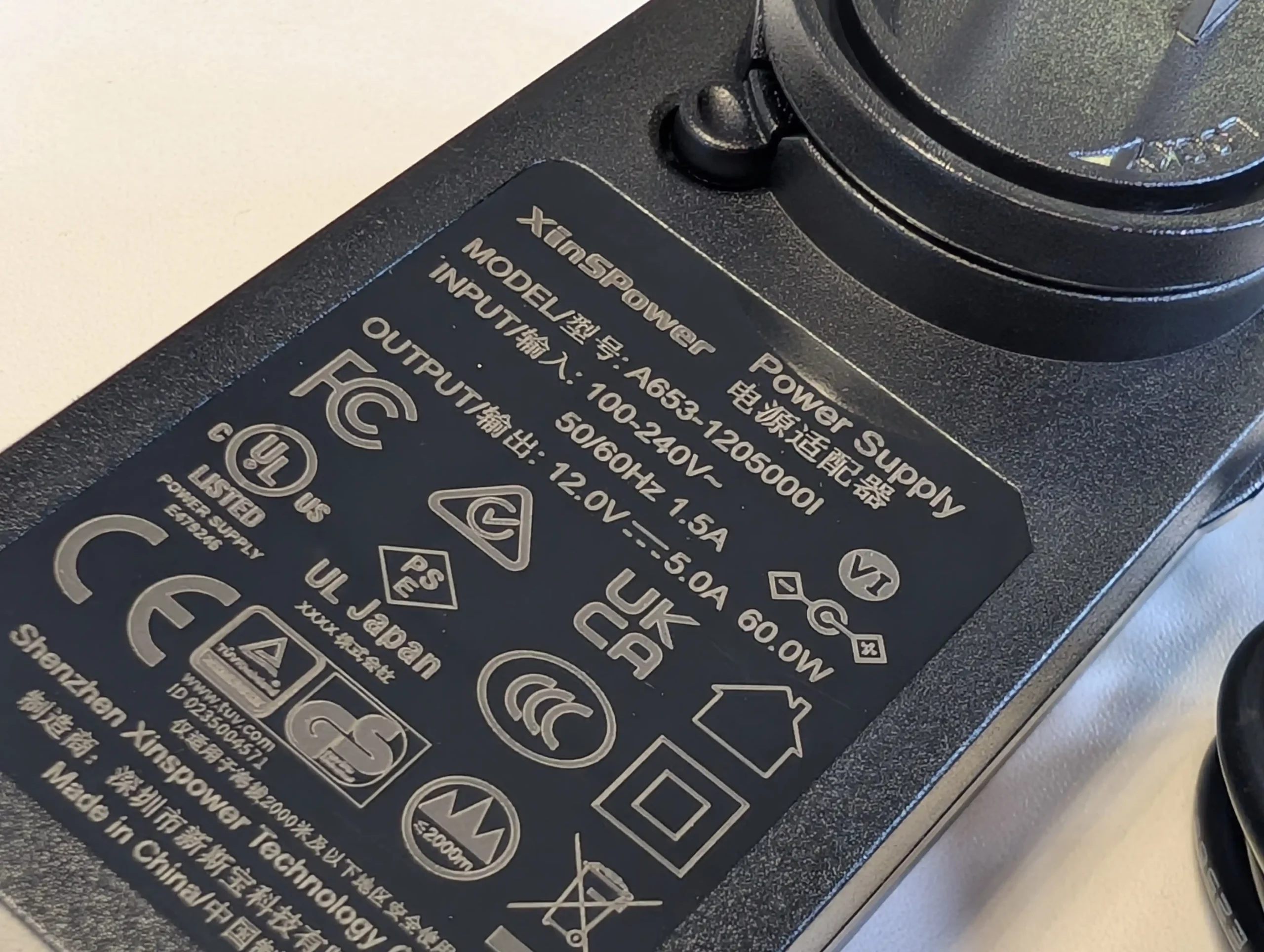
The barrel connector feels like an outdated choice and limits power supply flexibility. On a positive note, the included 60W power adapter is compact and efficient.
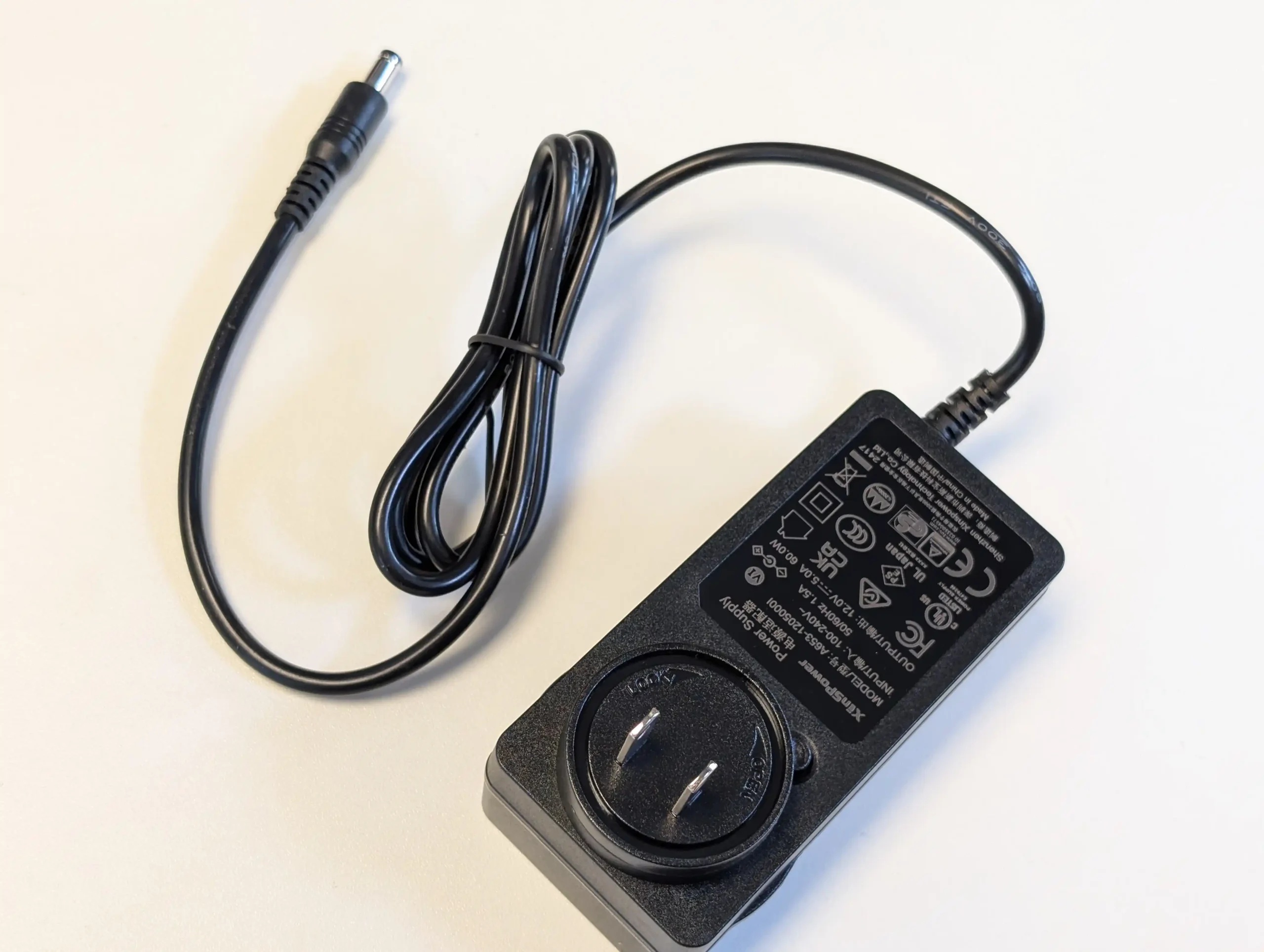
The port selection is limited, with only two USB 3.2 Gen 2 ports (10 Gbps) and two HDMI 2.0 outputs supporting up to 4K 60Hz displays. Users planning to use UnRAID or similar OSes via USB may quickly find the two ports insufficient, especially if they need one for a keyboard or KVM switch.
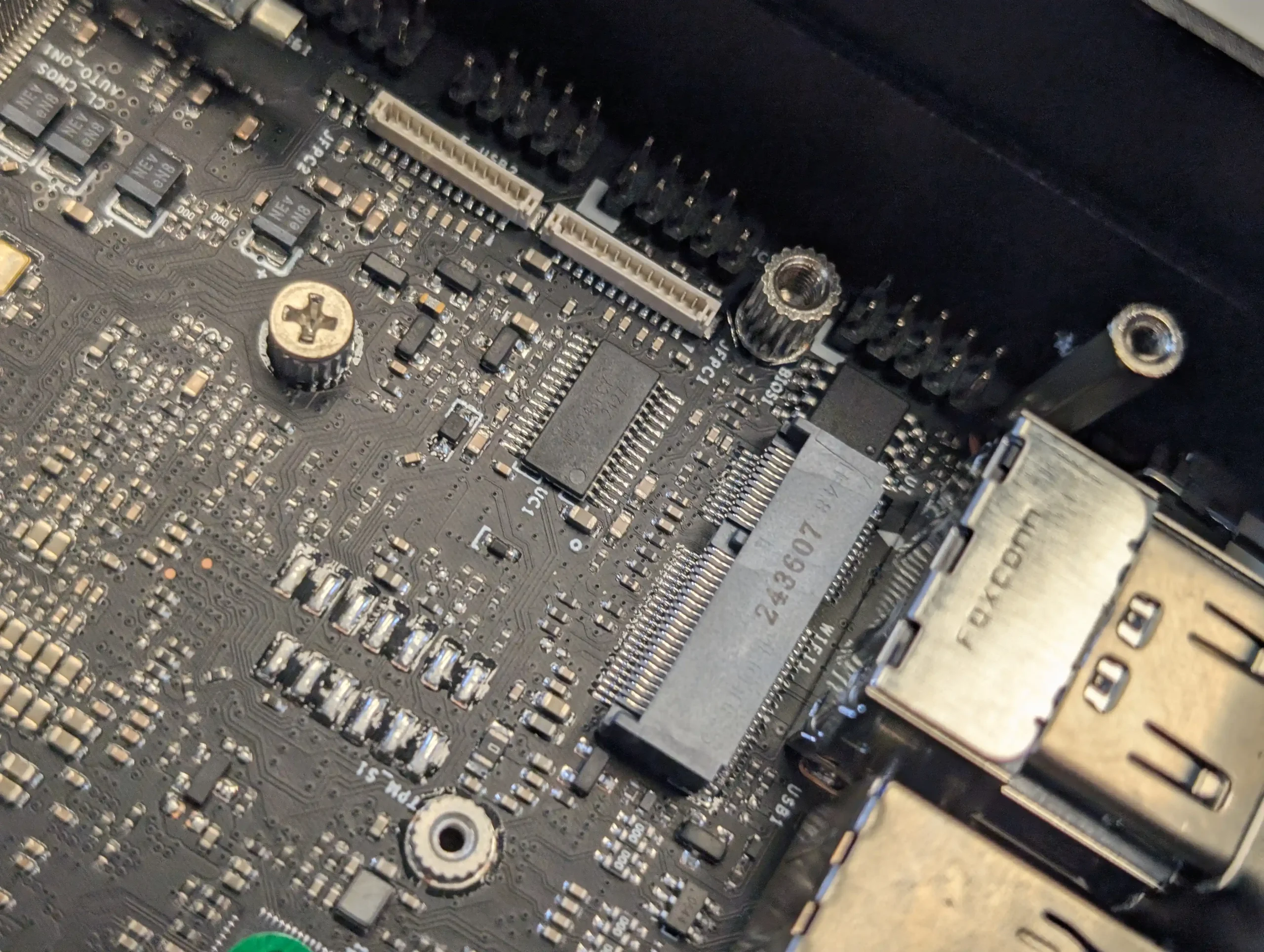
Additionally, the M.2 E-key slot for Wi-Fi 6 or 7 is present, but no antenna kit or Wi-Fi module is included, adding extra cost for wireless connectivity.
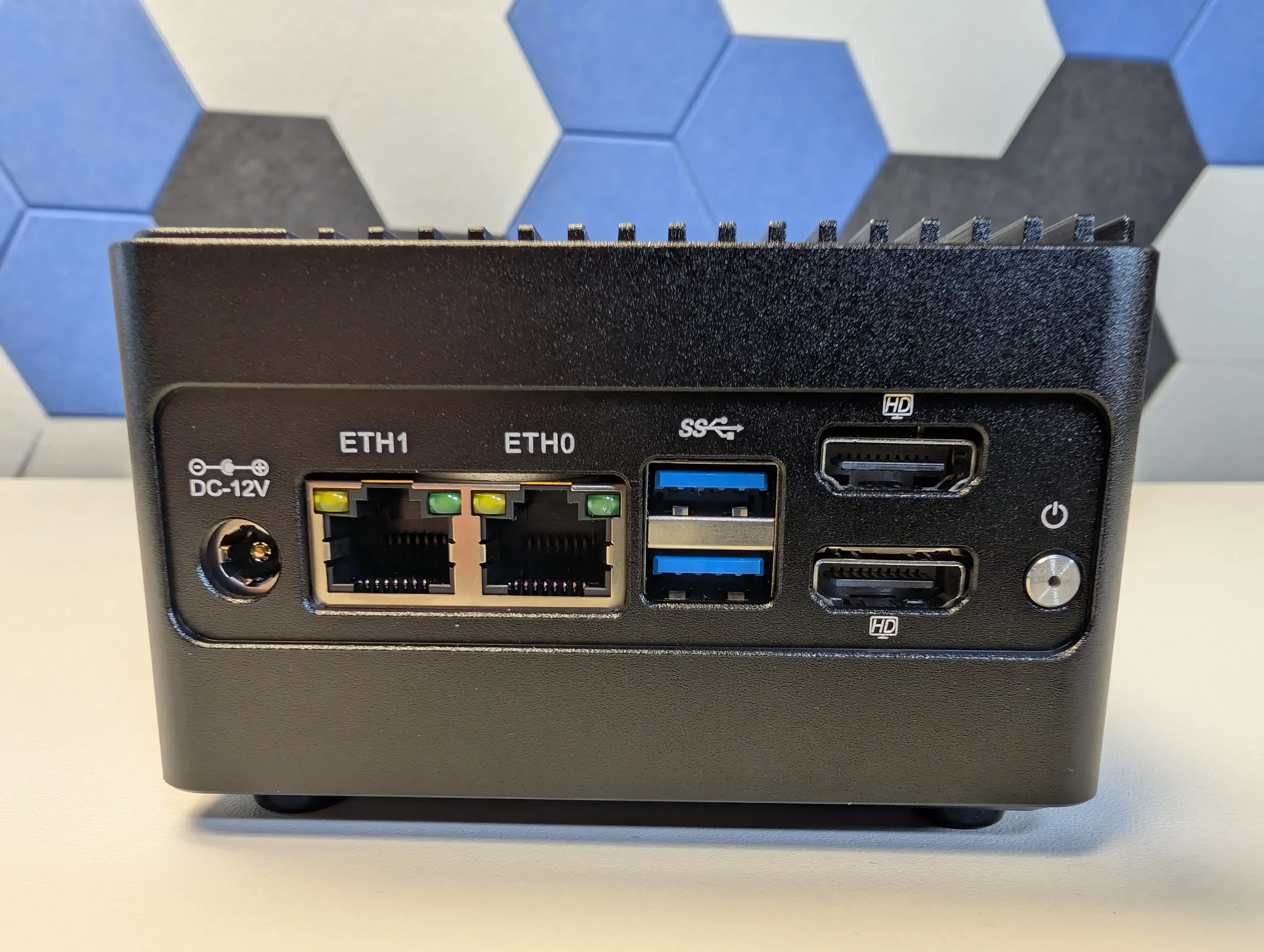
The included thermal pads for the M.2 drives are extremely thin, providing minimal heat dissipation.
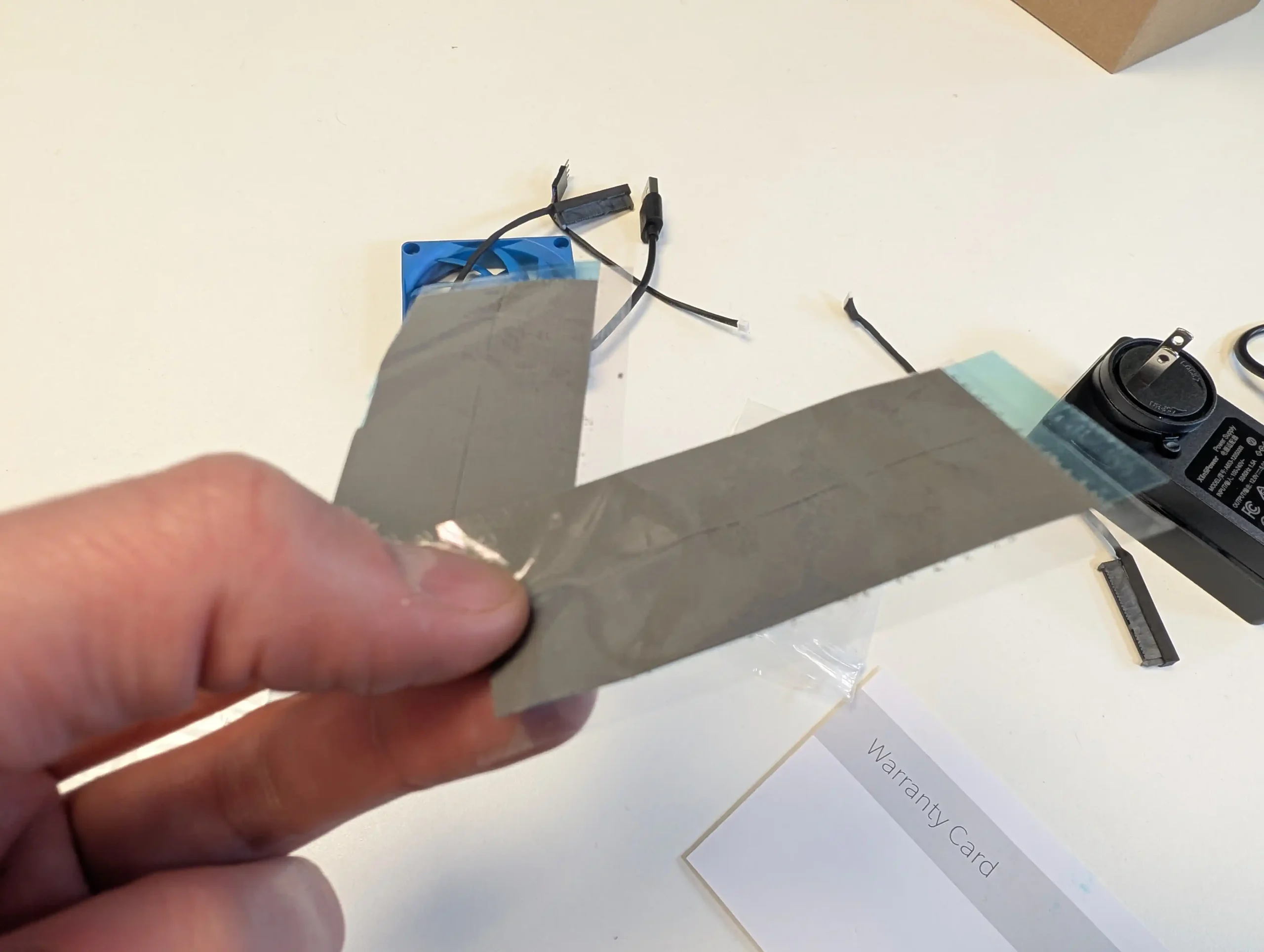
During sustained workloads, SSD temperatures rose above 65°C, but using third-party thermal pads reduced peak temperatures by approximately 10°C, enhancing performance stability.
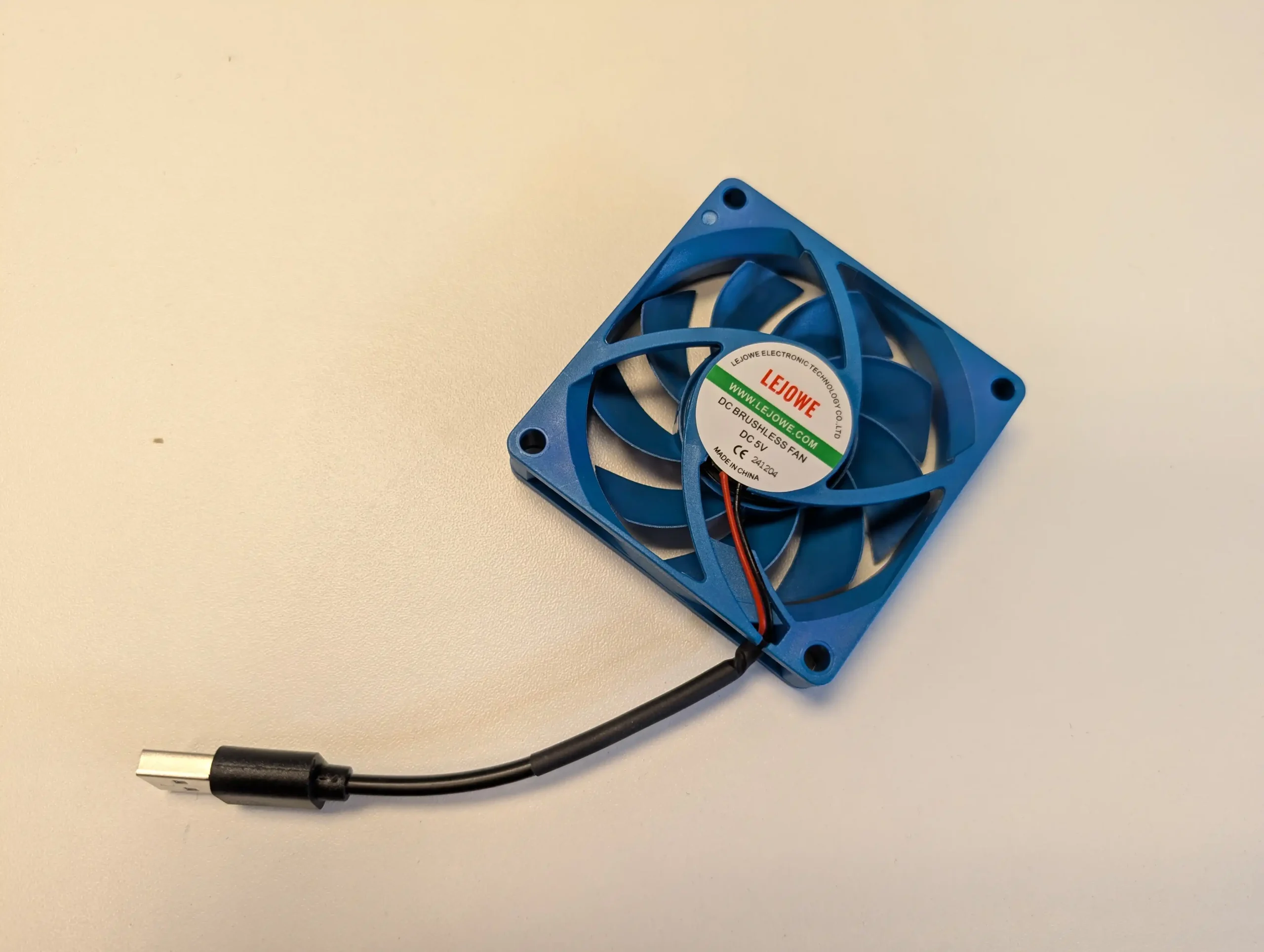
The optional external fan, which attaches to the top panel via USB, helps reduce SSD temperatures during sustained workloads but at the cost of a higher noise level.

Overall, the design feels solid but because they have had to cram a lot into a small space, the potential for airflow in key areas might be pretty poor (hence the included optional USB fan). While the cooling solution is effective, port limitations, poor-quality thermal pads, and the choice of barrel power input are significant drawbacks.
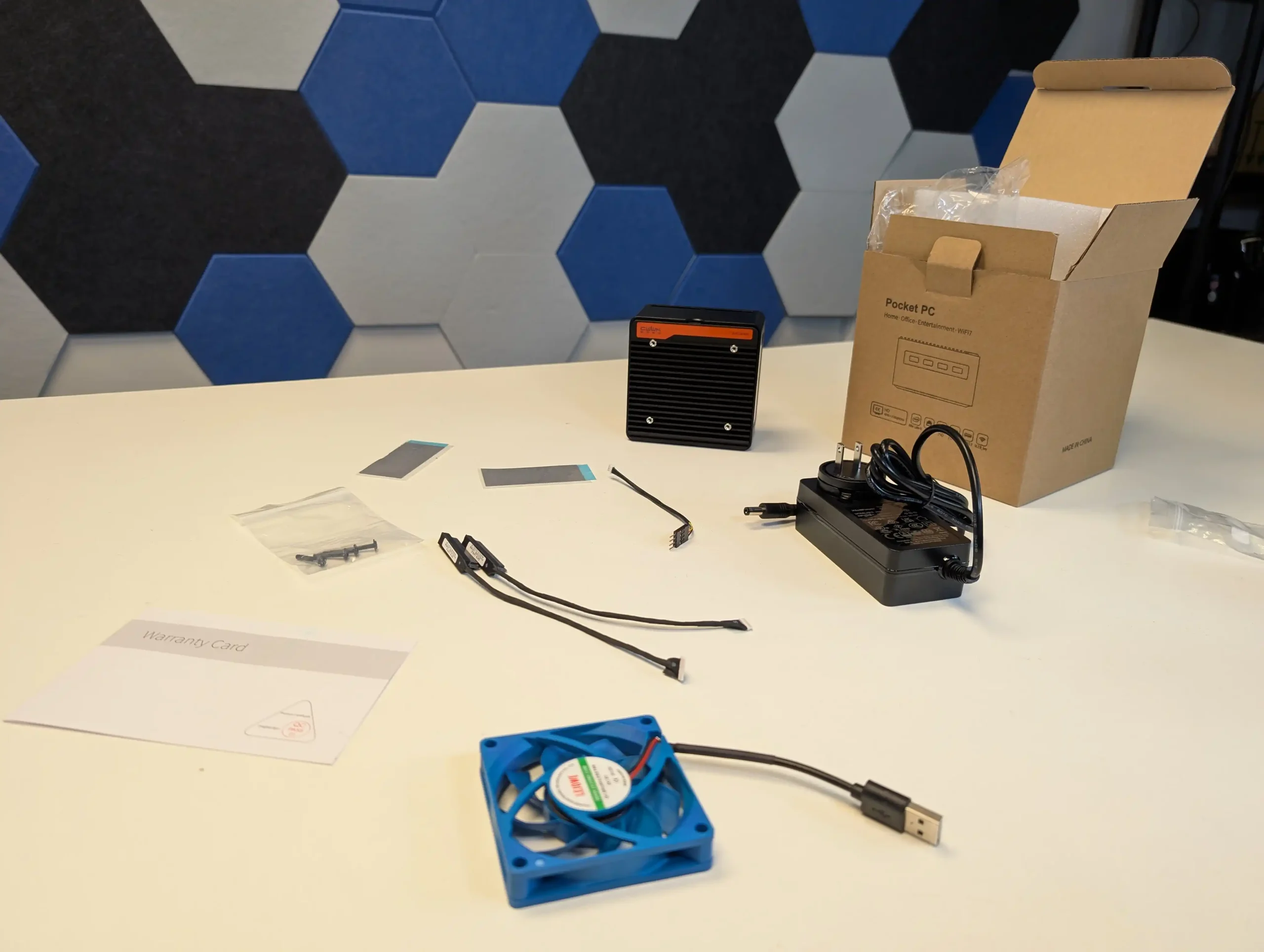
Despite these issues, the compact size and all-metal construction make it an attractive option for users needing a small yet powerful NAS.
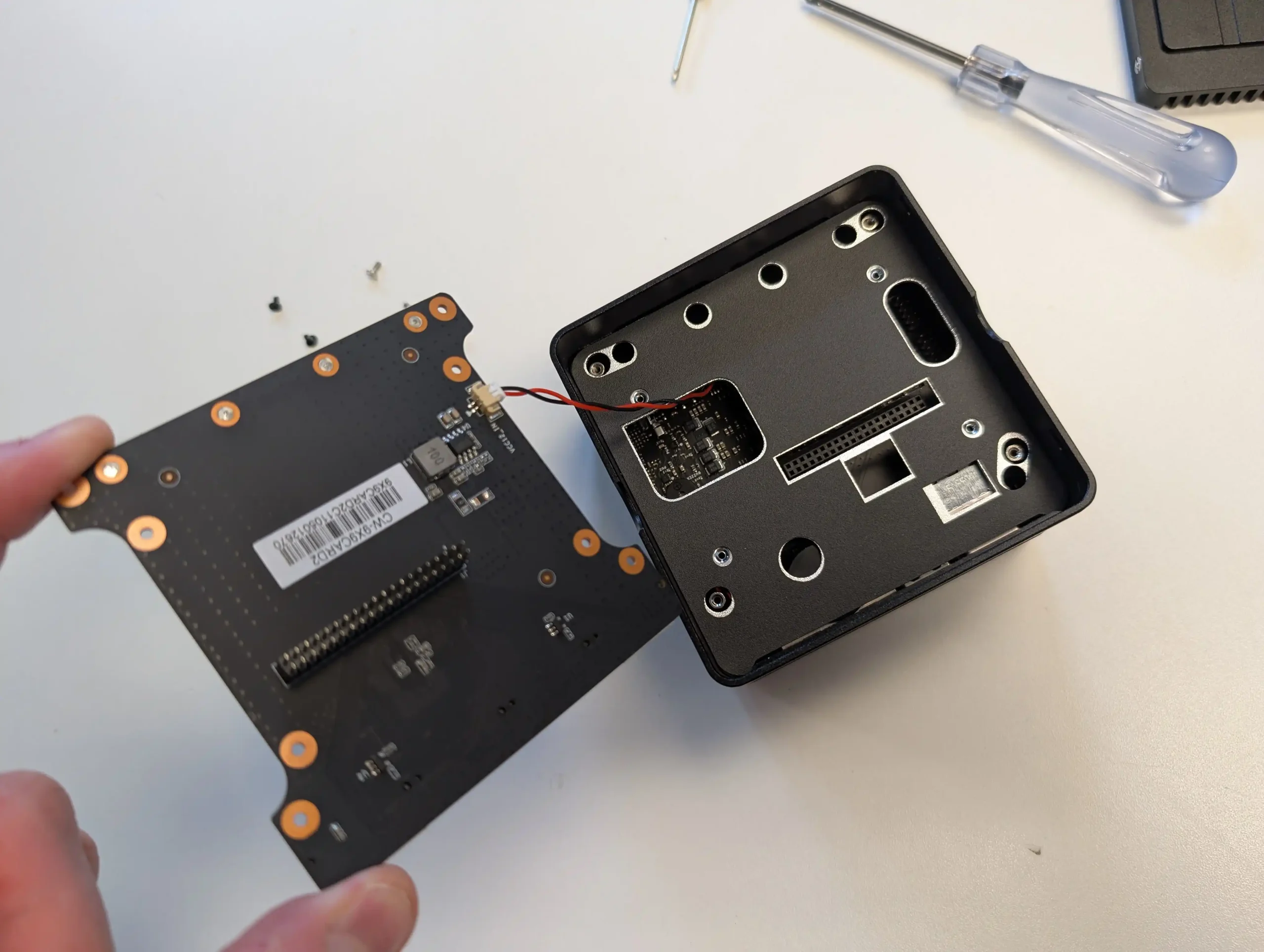
CWWK x86 P6 NAS Review – Internal Hardware
The CWWK P6 is powered by Intel Twin Lake processors, offering two configurations: the quad-core N150 (up to 3.6 GHz, 6W TDP) and the octa-core N355 (up to 3.9 GHz, 15W TDP). The N355 version tested here features eight cores, 32EU Intel UHD graphics at 1.35 GHz, and a TDP of 15W, making it more suitable for virtualization, container workloads, and media streaming.
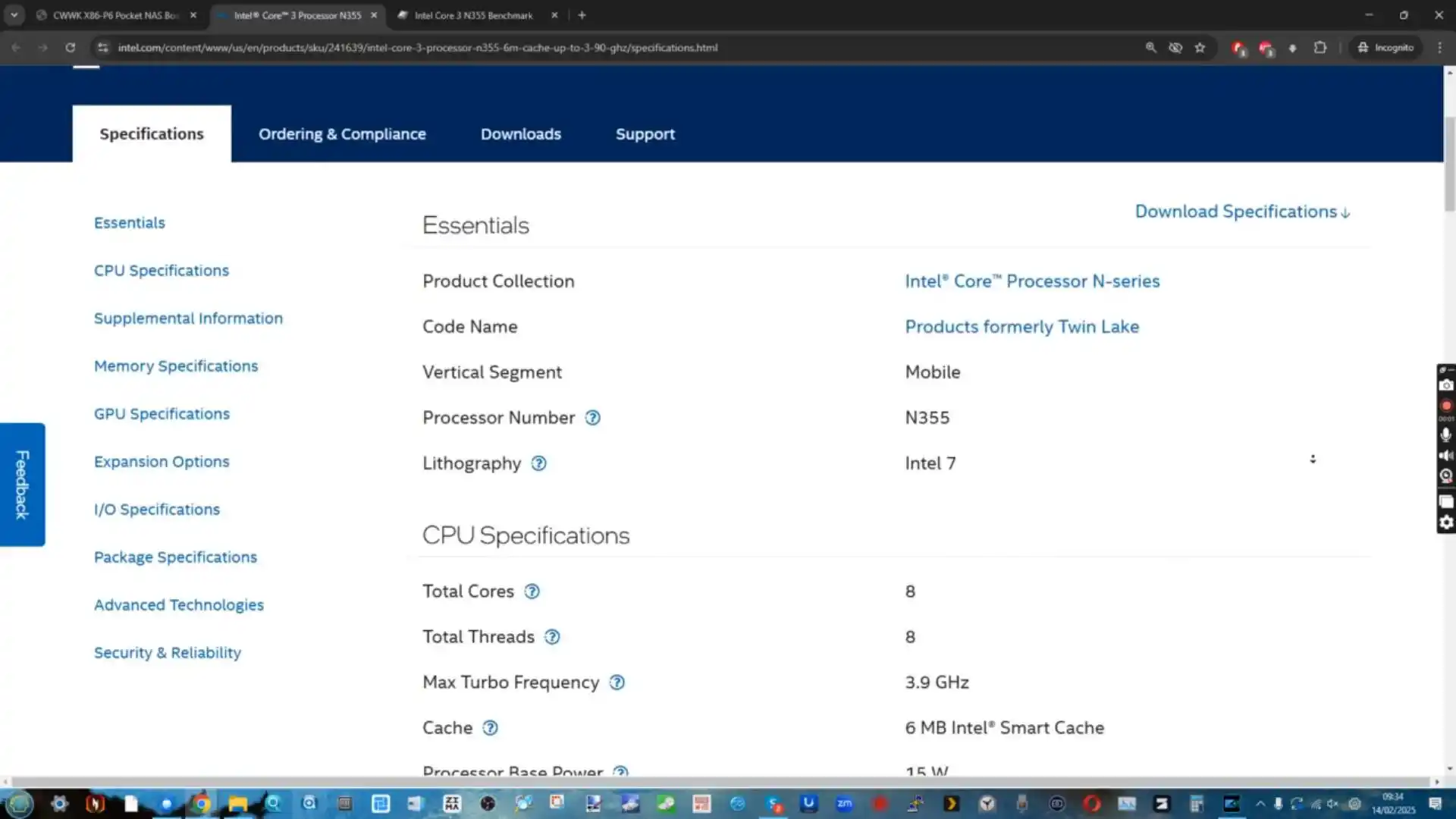
The system uses one SO-DIMM DDR5 slot, supporting up to 48GB of non-ECC DDR5 4800 MHz RAM. While the single-channel configuration may reduce memory performance, the high RAM ceiling is useful for running multiple VMs or containers. The absence of ECC memory support may be a concern for users seeking data integrity in a server environment, but again – at this price it is tough to be overly critical about this here.
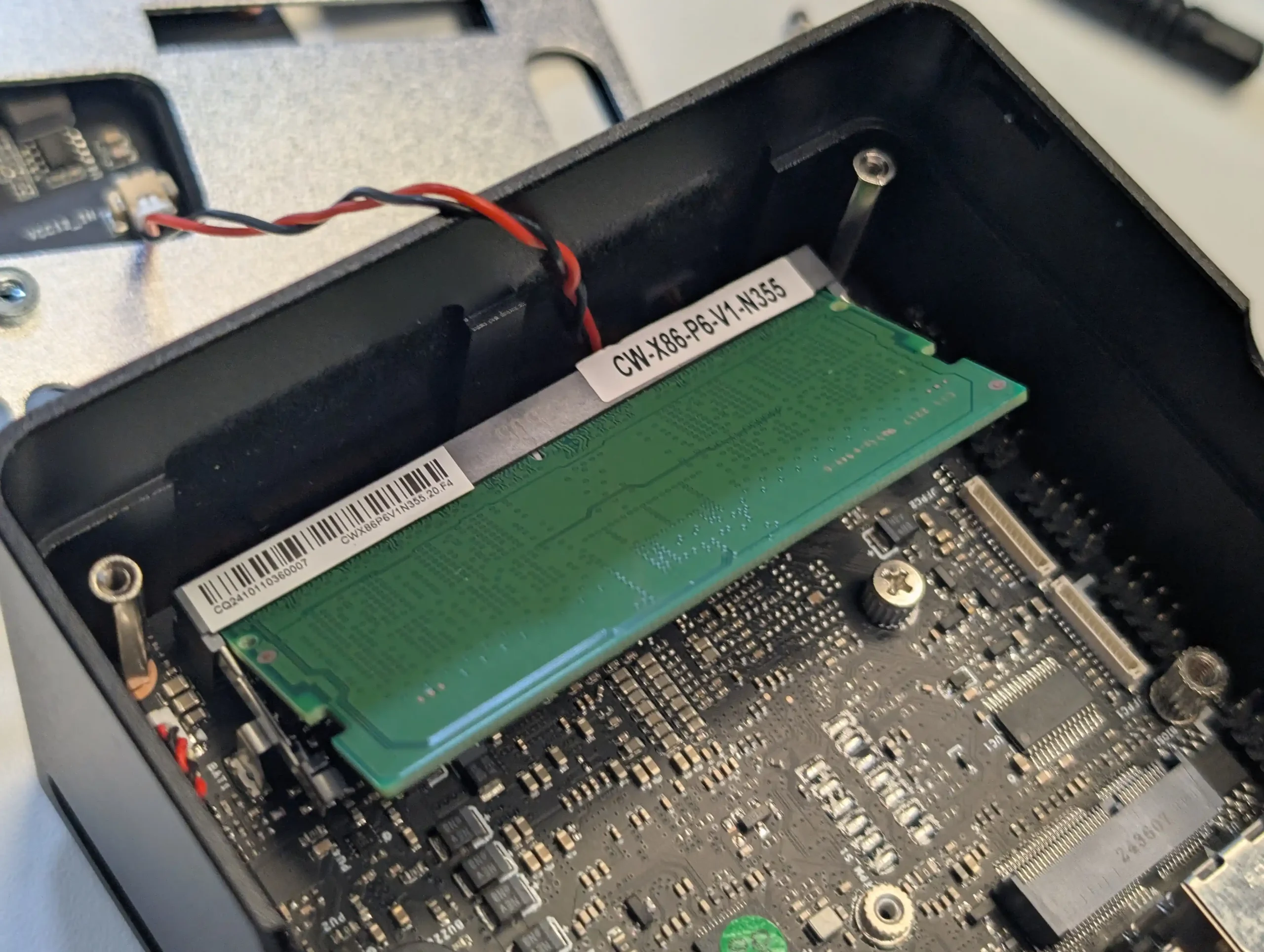
For networking, the P6 includes two 2.5GbE ports, controlled by Intel i226V controllers, supporting SMB multichannel and link aggregation. During testing, the 2.5GbE ports achieved up to 550 MB/s combined throughput with link aggregation. However, the lack of 10GbE is a missed opportunity, given the PCIe limitations on M.2 throughput, which could benefit from faster networking.
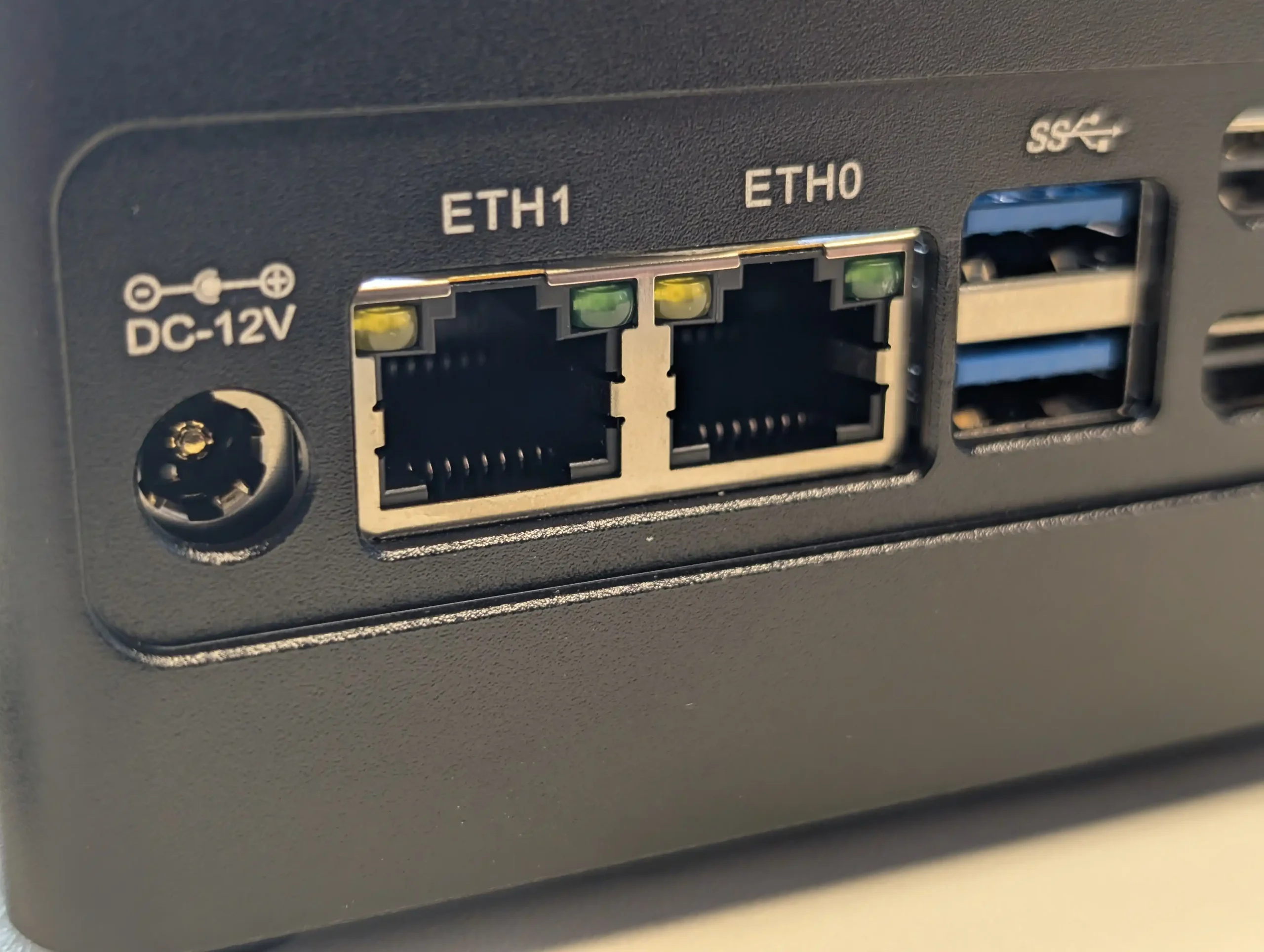
A M.2 E-key slot is provided for Wi-Fi 6 or 7 modules, but no module or antenna is included. Additionally, while the motherboard supports auto power-on, Wake-on-LAN (WoL), and PXE boot, the BIOS lacks some advanced settings found on other DIY NAS boards – however the N355 CPU itself is already getting stretched pretty thin here, so the scope for modification is pretty slim anyway to be honest.
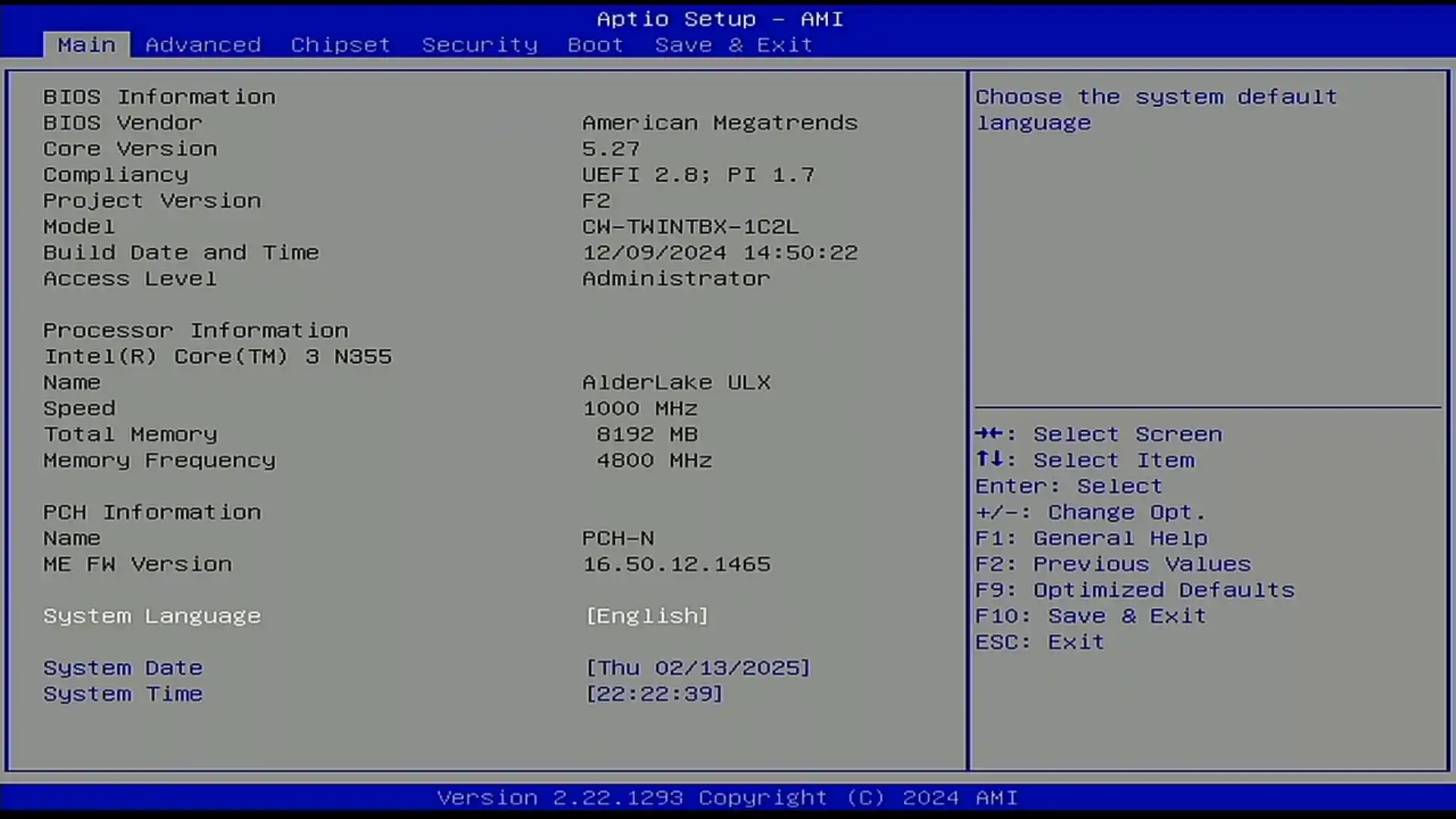
One notable advantage is the expandability of the M.2 slots, which can be used for more than just storage. Users can install M.2 to PCIe adapters for 10GbE network cards, PCIe expansion cards, or even OCuLink adapters for external storage enclosures. This flexibility allows the P6 to be tailored for different use cases, such as adding 10GbE for faster networking or expanding with a PCIe card for additional functions. This feature partially offsets the lack of built-in 10GbE and adds versatility to the system.
| RECOMMENDED M.2 ADAPTERS
M.2 to 10GbE Adapter – BUY HERE – REVIEW HERE M.2 to PCIe Card Slot Adapter – BUY HERE – REVIEW HERE M.2 to Oculink 4i Adapter – BUY HERE – REVIEW HERE |
CWWK x86 P6 NAS Review – Storage
The CWWK P6 is built around four M.2 NVMe 2280 slots (PCIe 3.0 x1), supporting high-speed, flash-based storage. Each slot has a maximum theoretical throughput of around 800 MB/s, which is suitable for general NAS tasks but limits RAID performance.
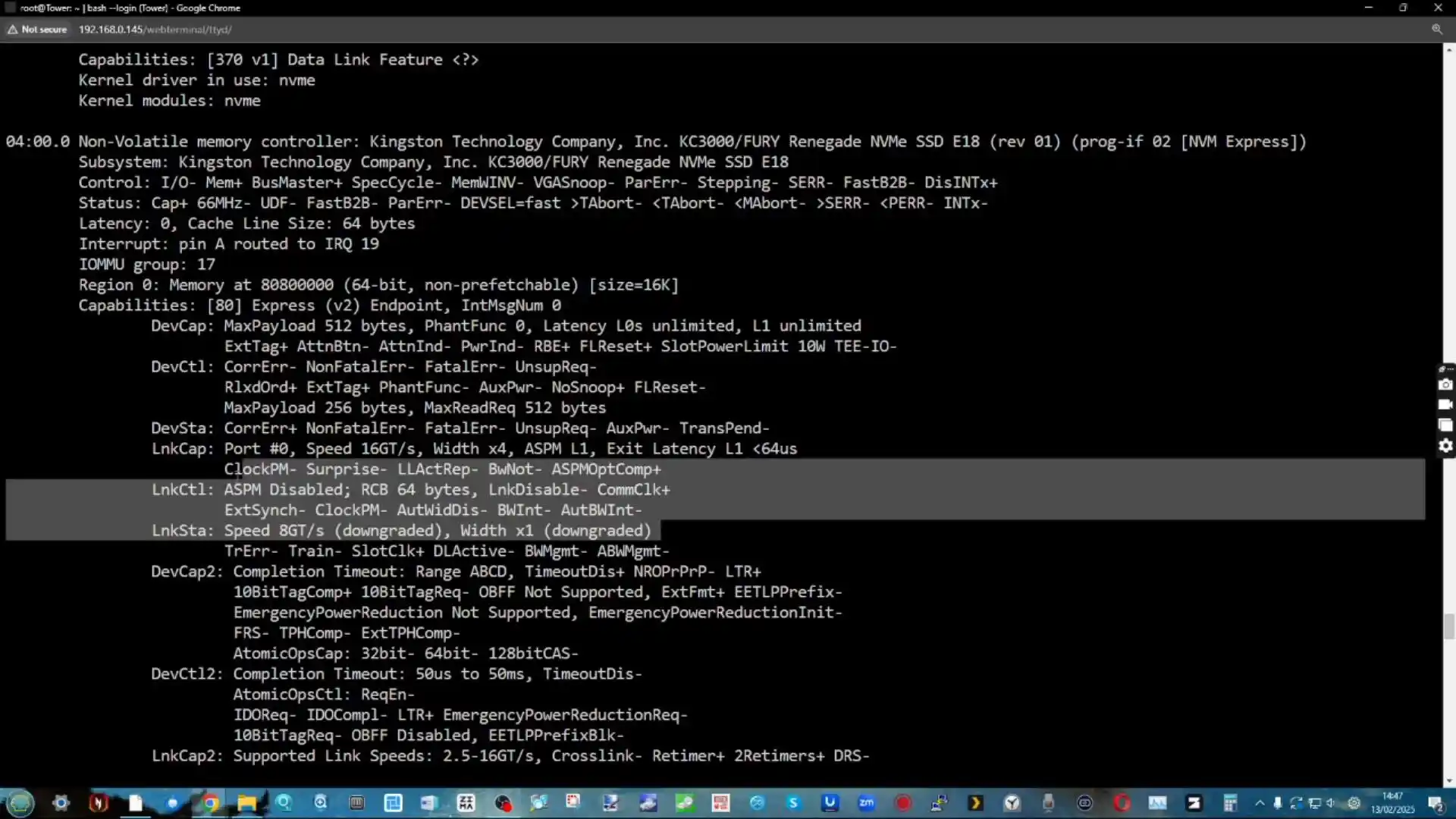
The absence of screw holes for shorter M.2 sizes means users must use full-length 2280 drives.
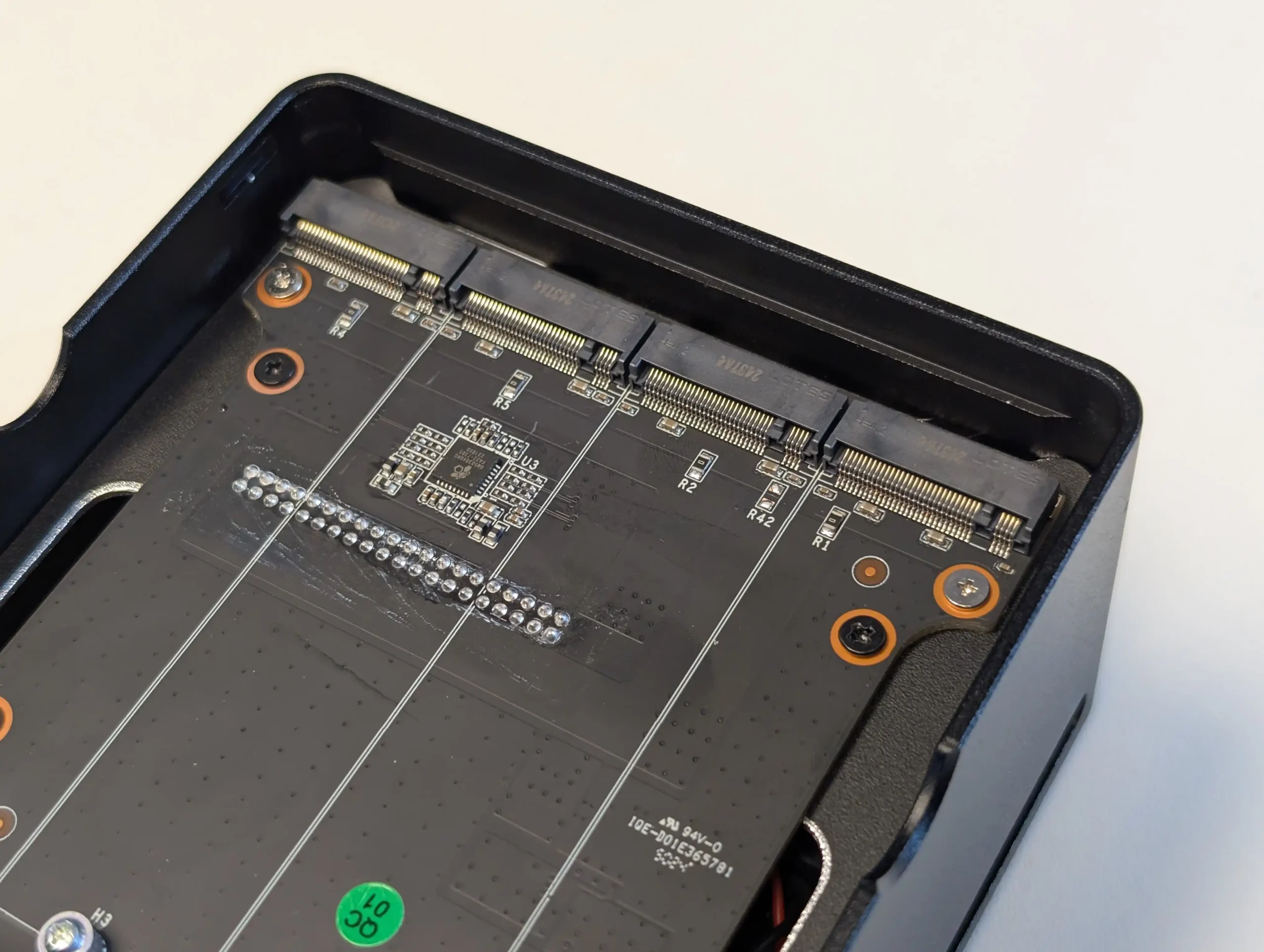
The included thermal pads are surprisingly thin and for an all flash system, a little underwhelming, but given the 3×1 speed of each bay, just how hot each SSD will be getting is debatable.
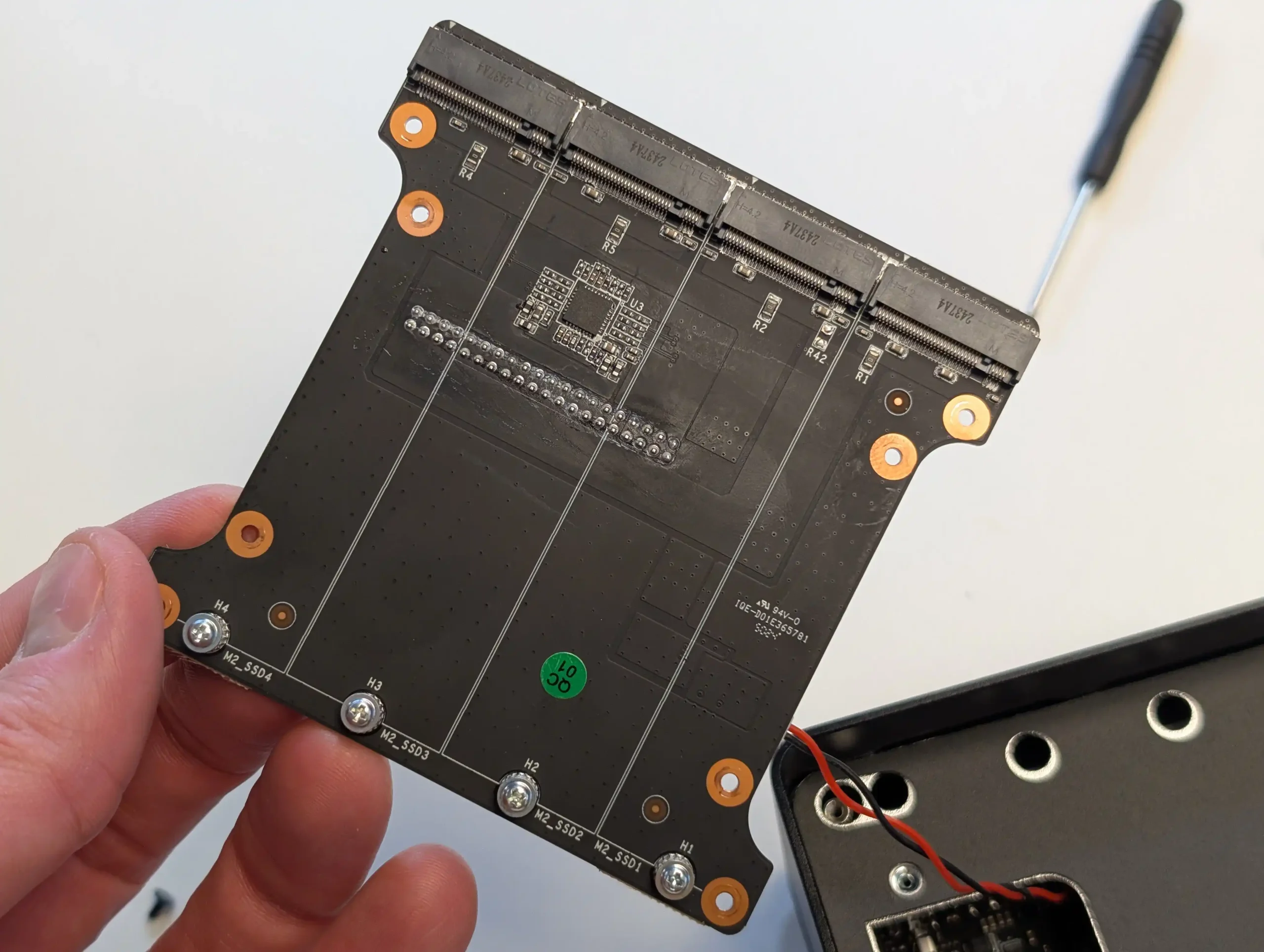
The four M.2 NVMe SSD Bays are mounted on a a sister board that is connected on it’s underside with a 40 pin connector into ANOTHER m.2 NVMe PCB that is in a single m.2 2280 SSD slot on the lower micro motherboard.

The M.2’s profile is still being investigated, but it IS a novel way of getting around the limitations of the base N150/N355 PCU Lanes and physical distribution that a single board would have needed to counter/work-around.
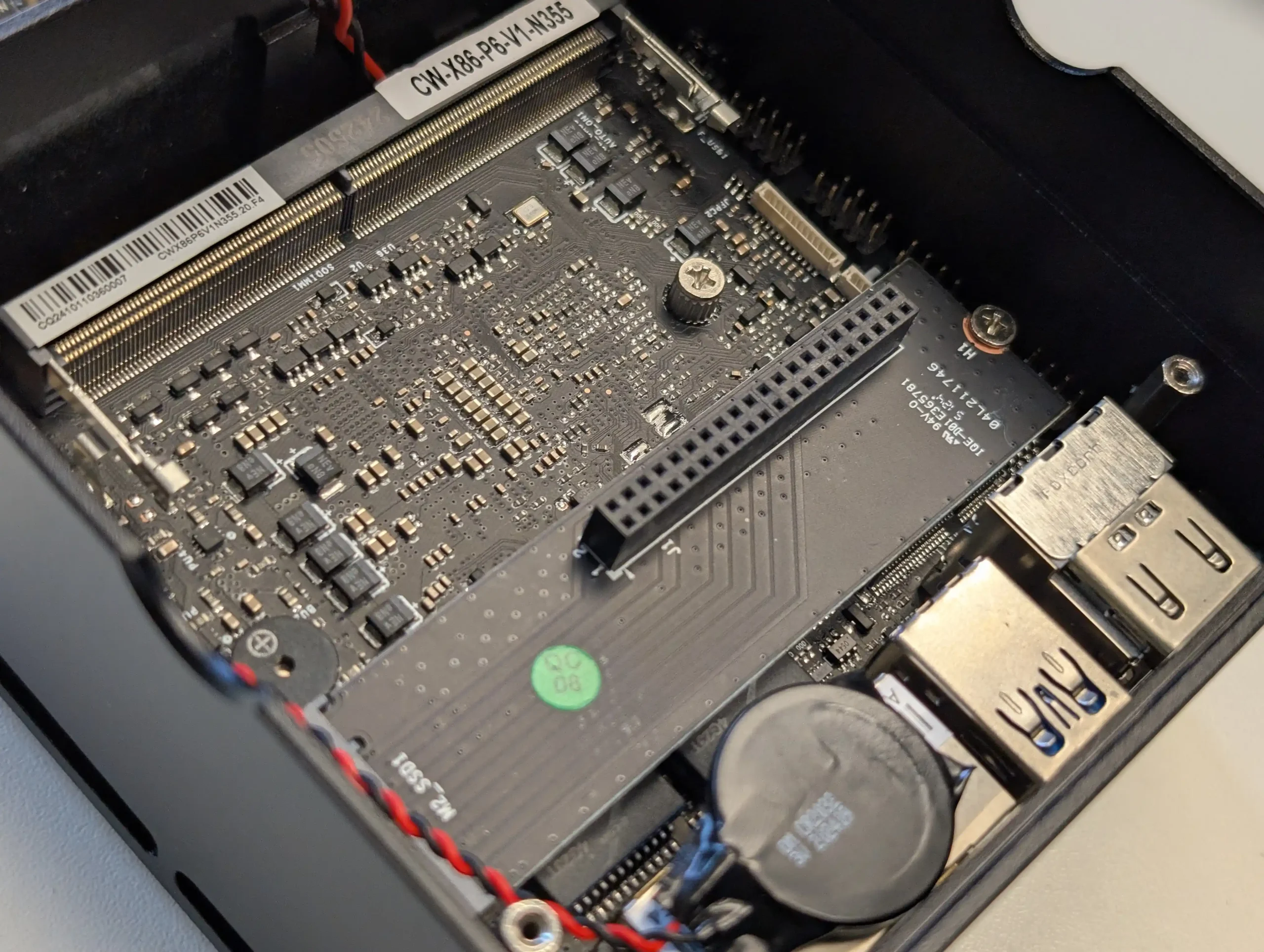
During sustained workloads, SSD temperatures rose above 65°C, but using third-party thermal pads reduced peak temperatures by approximately 10°C, enhancing performance stability. The optional top-mounted fan offers additional cooling but increases noise levels.
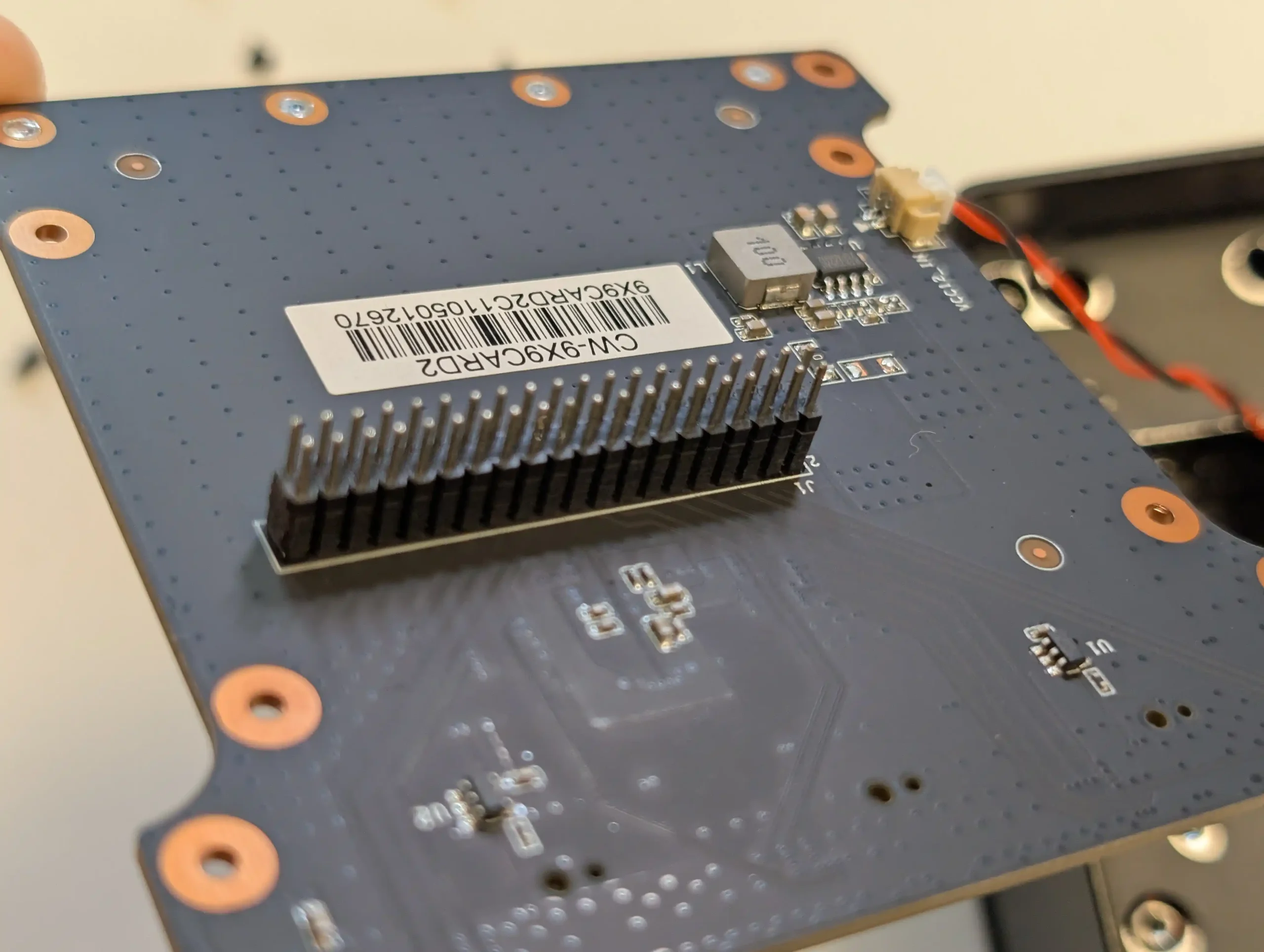
The P6 includes an unusual SATA expansion option using JFPC1 ribbon cables connected to the motherboard. While the implementation is unconventional, it is understandable given the small internal space constraints.
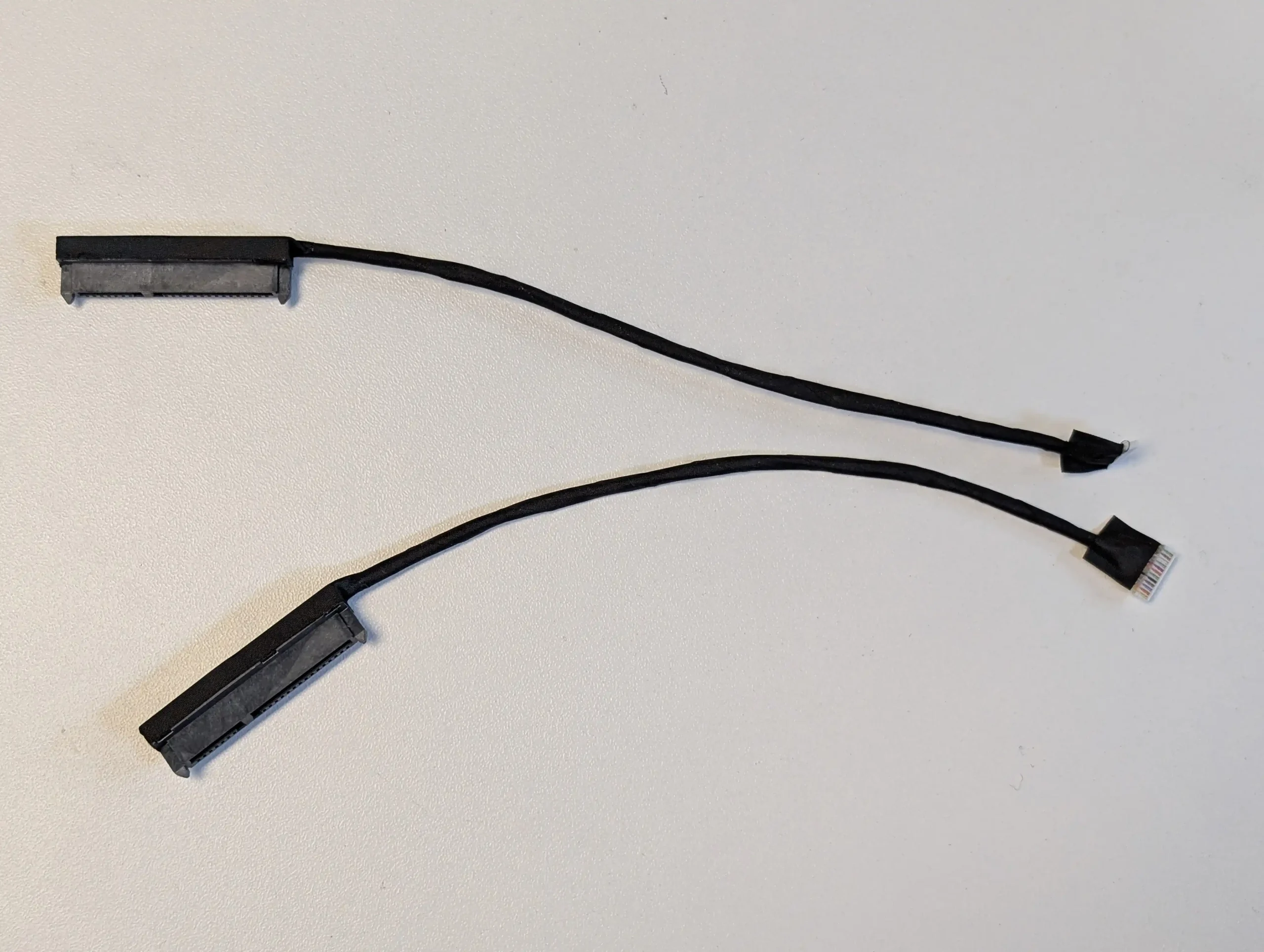
During testing, these SATA drives were detected in the BIOS but not recognized by the OS, indicating possible BIOS or driver issues.
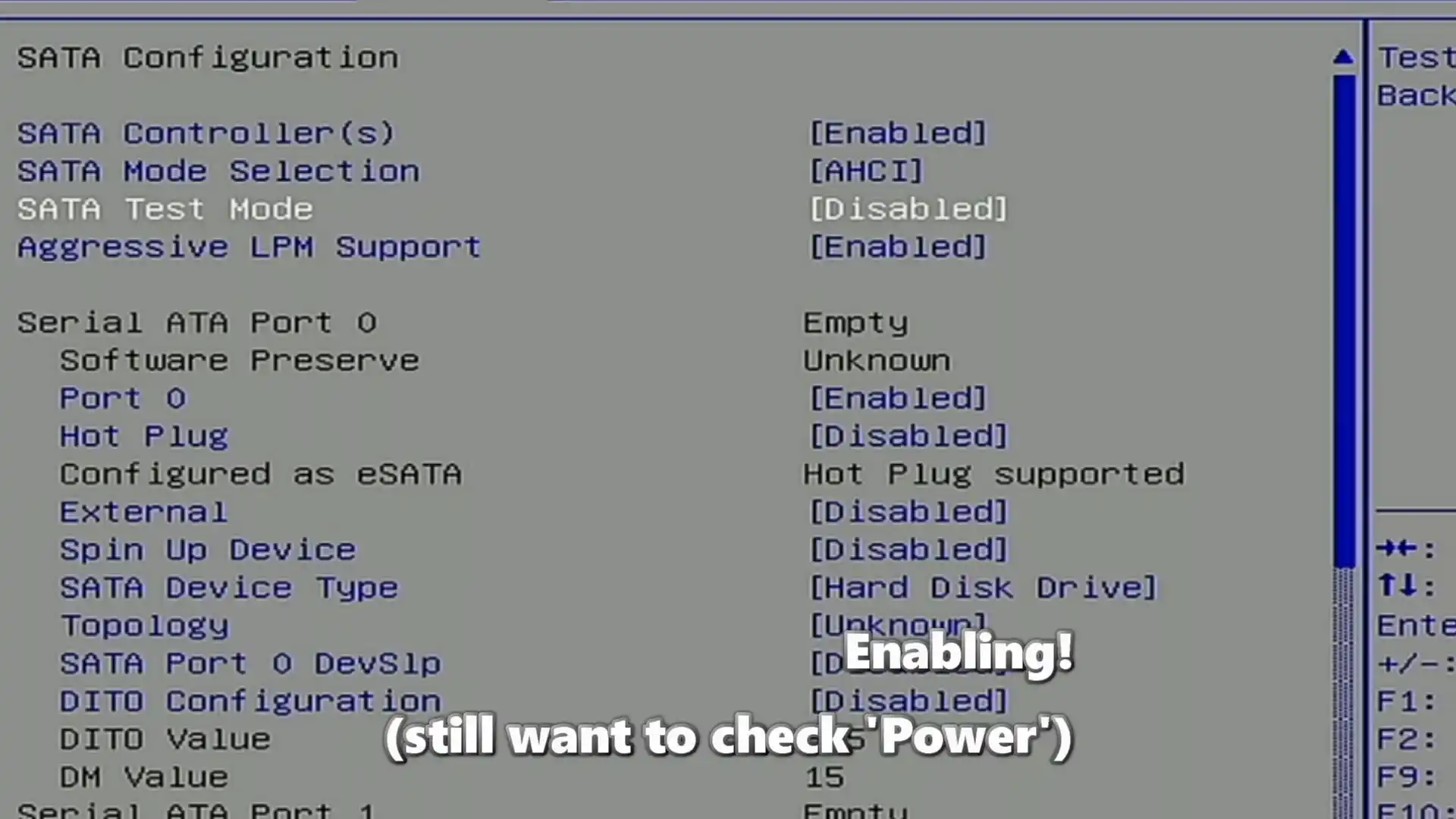
It is worth noting that the inclusion of SATA connectivity is a welcome option for users needing low-cost storage expansion, though it may require further configuration.

As mentioned earlier, the lack of an internal PCIe slot limits storage expansion of course. However, users can convert an M.2 slot to a 10GbE network card, PCIe expansion, or even OCuLink storage expansion using third-party adapters. This flexibility is a notable advantage but comes at the cost of losing an M.2 storage slot.
Overall, the storage system is functional but limited by PCIe lane bottlenecks and poor SATA support implementation. Users seeking high-speed RAID configurations may be disappointed, but for NVMe-based storage pools, virtualization, and caching, the P6 performs well within its hardware constraints.
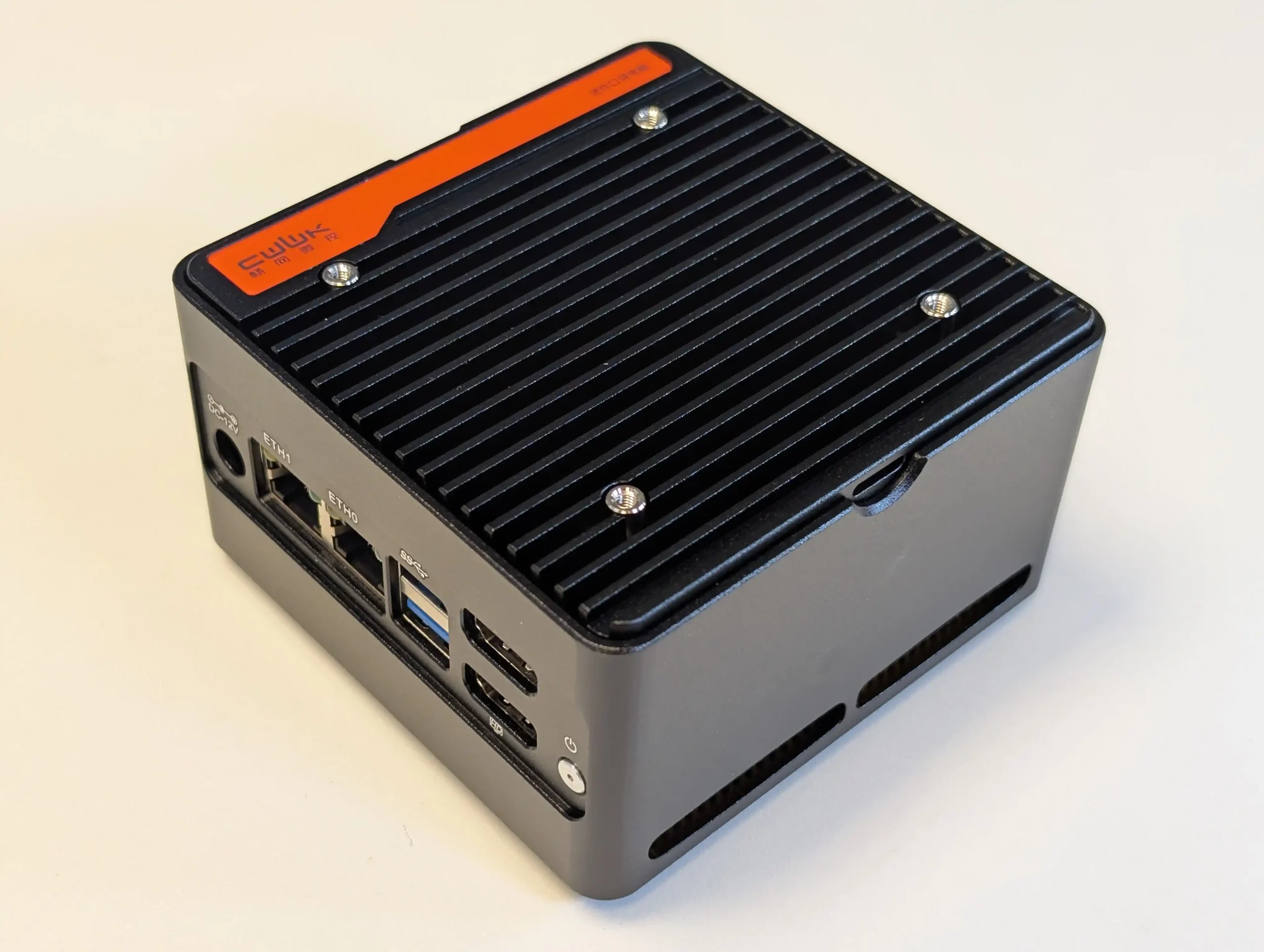
CWWK x86 P6 NAS Review – Tests & Performance
In this section, we evaluate the CWWK x86 P6 Pocket SSD NAS based on its SSD speeds, power consumption, noise levels, and thermal performance. Using the N355 octa-core model with four M.2 NVMe SSDs, we tested its performance under different workloads, including file transfers, virtualization, and media streaming. Even initial VM testing was pretty promising, when I ran three Windows 10 VMs, at 1 Core and 2GB Memory – there was still plenty of H/WW remaining to play with and each VM ran well. Just keep in mind that you only have 8 threads (i.e 8 vCPU) to assign.
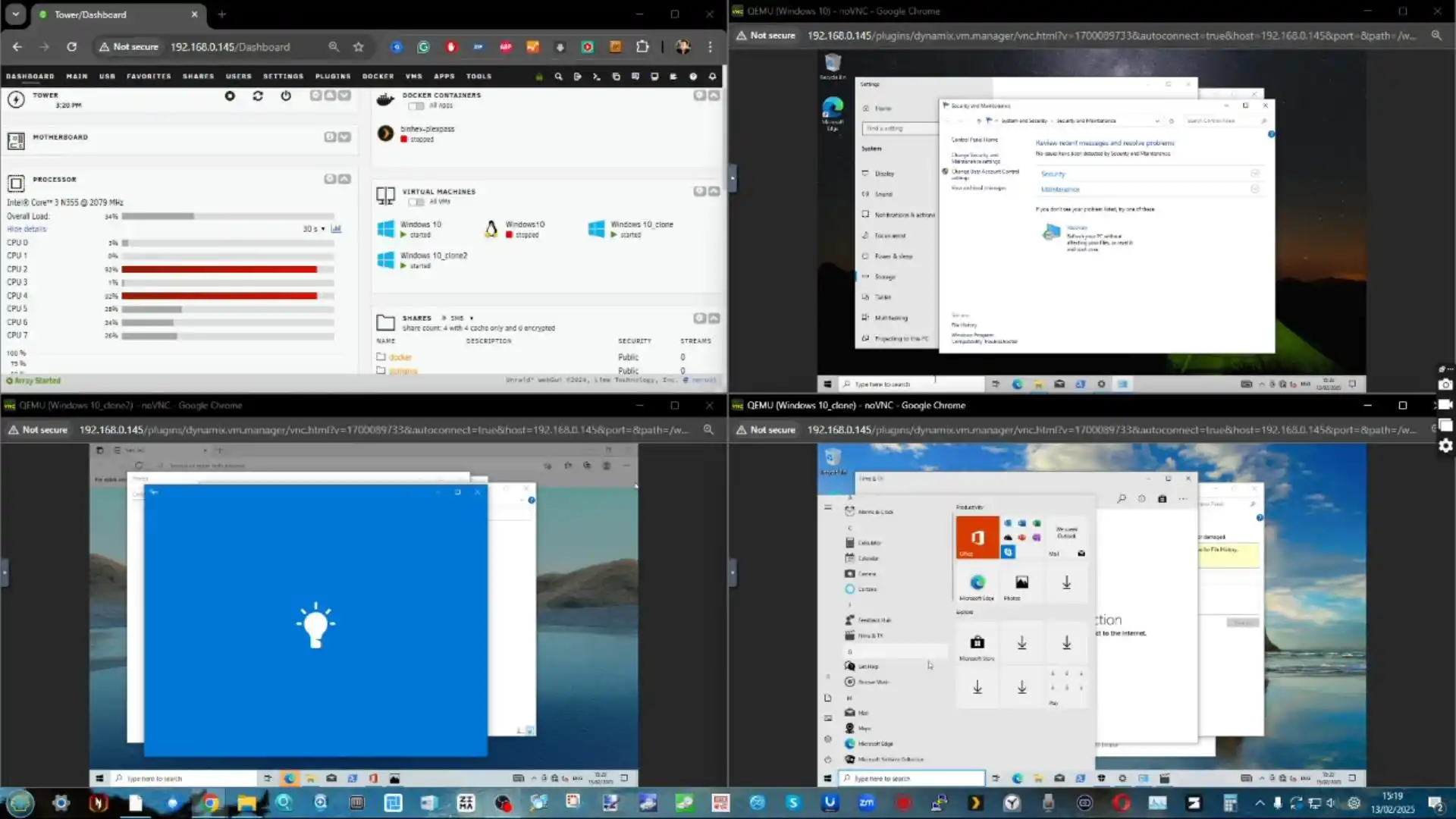
We also measured how efficiently the system manages power and heat under load. Our tests aim to give a clear, practical understanding of what users can expect from the P6, particularly for tasks like running small scale containers or virtual machines or acting as a domestic/home/family media server, while considering its design limitations, such as PCIe lane constraints and cooling efficiency.
SSD Performance:
In our tests with four M.2 NVMe SSDs (PCIe 3.0 x1):
- Single SSD (Sequential): 780–790 MB/s (Read), 690 MB/s (Write)
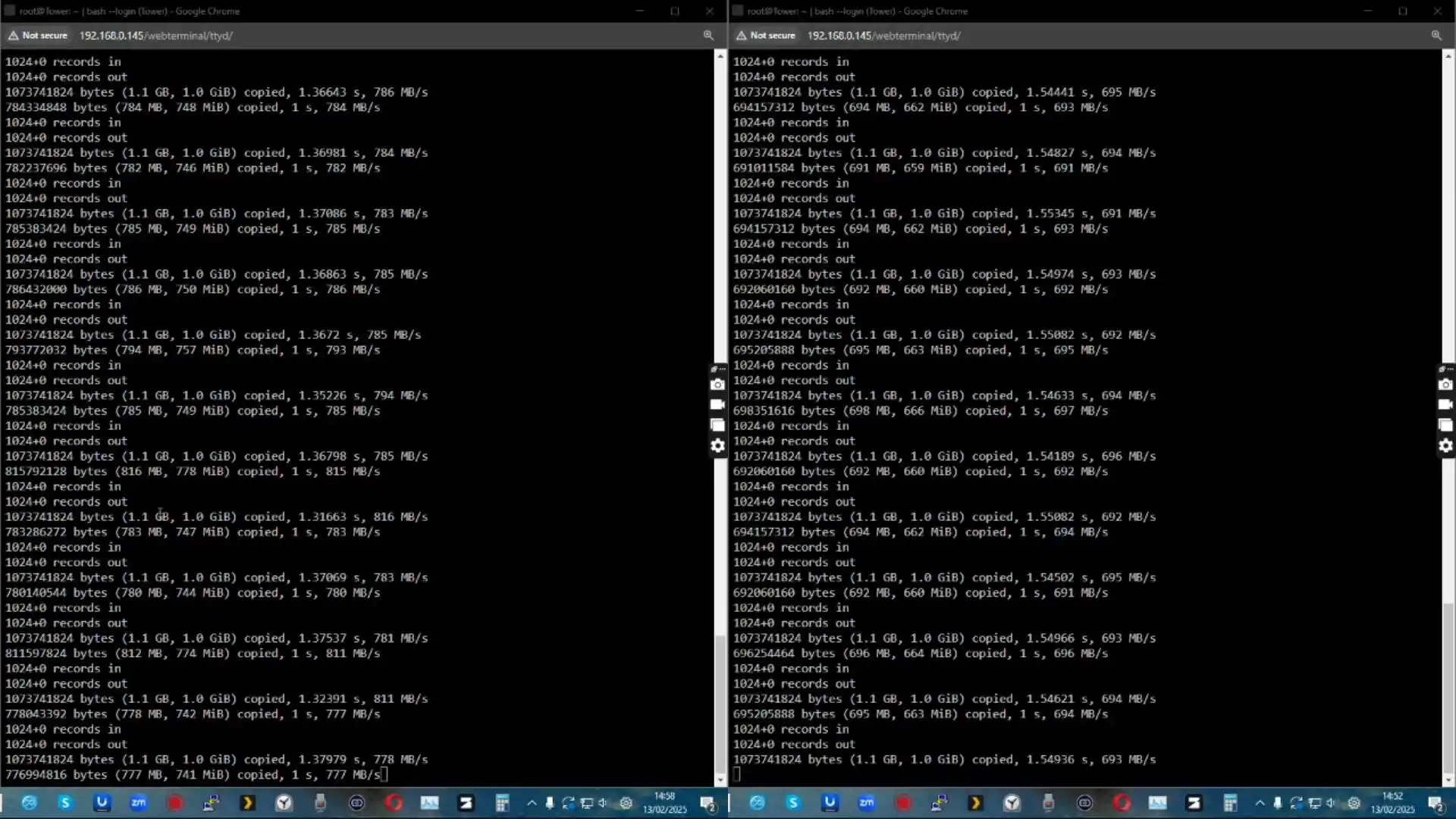
- Four SSDs Simultaneously: 450–520 MB/s aggregate throughput
The x1 PCIe lanes per slot are the primary bottleneck, but single-drive speeds are acceptable for general NAS usage. Performance drops significantly in RAID configurations due to lane sharing.
Power Consumption:
Measured during testing:
- Idle (No Drives): 18W
- All Four SSDs Under Load: 31–32W
- Three VMs with Disk Activity: 34–35W
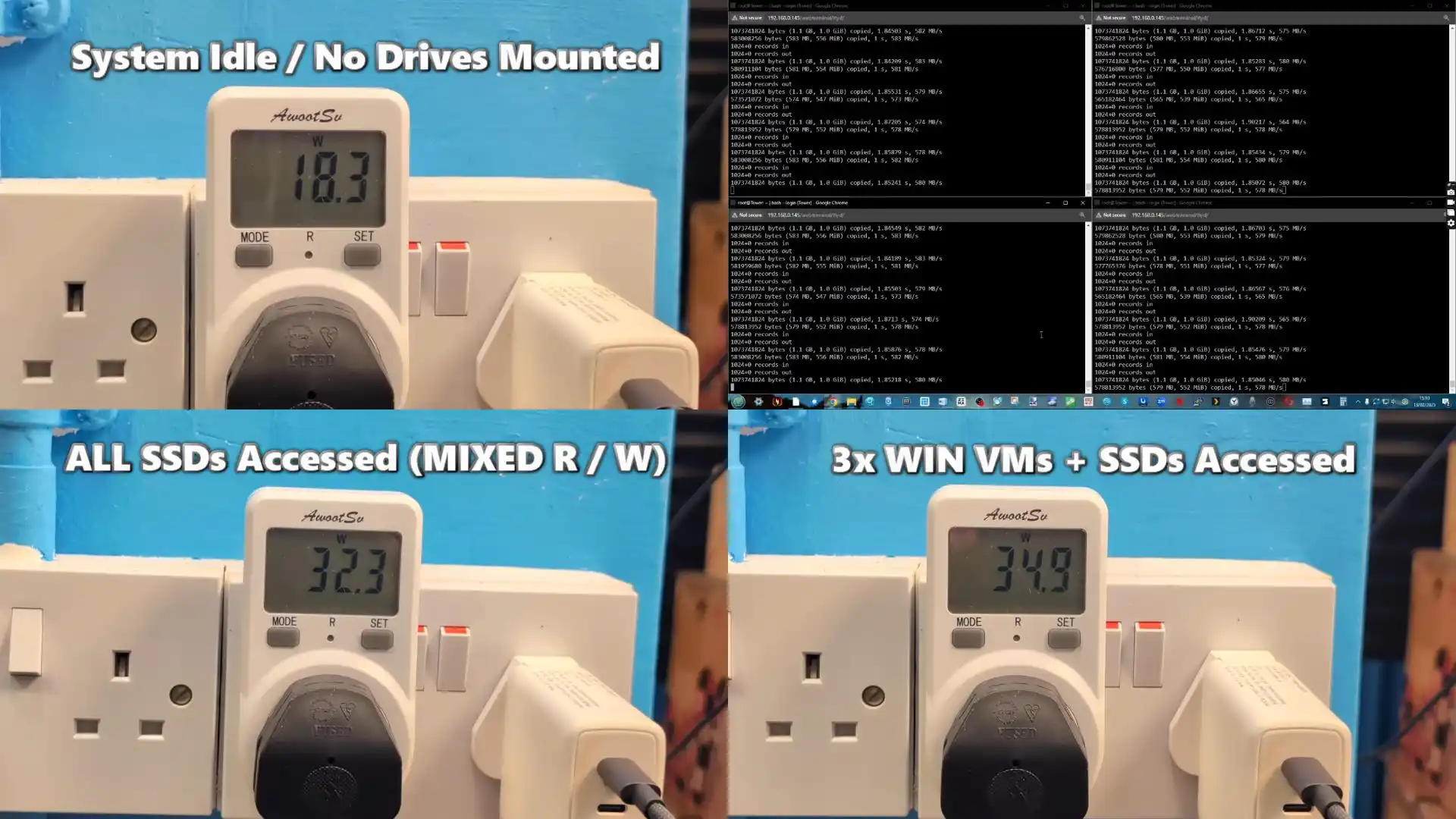
- Power efficiency is reasonable, and the 15W TDP N355 processor delivers a good balance of performance and efficiency.
Noise Levels:
- Base Fan Only (Peak): 35–36 dBA
- With Optional Top Fan: 38 dBA (noticeable but not disruptive)
The top fan is audibly louder, but effective for SSD cooling, especially during sustained workloads.
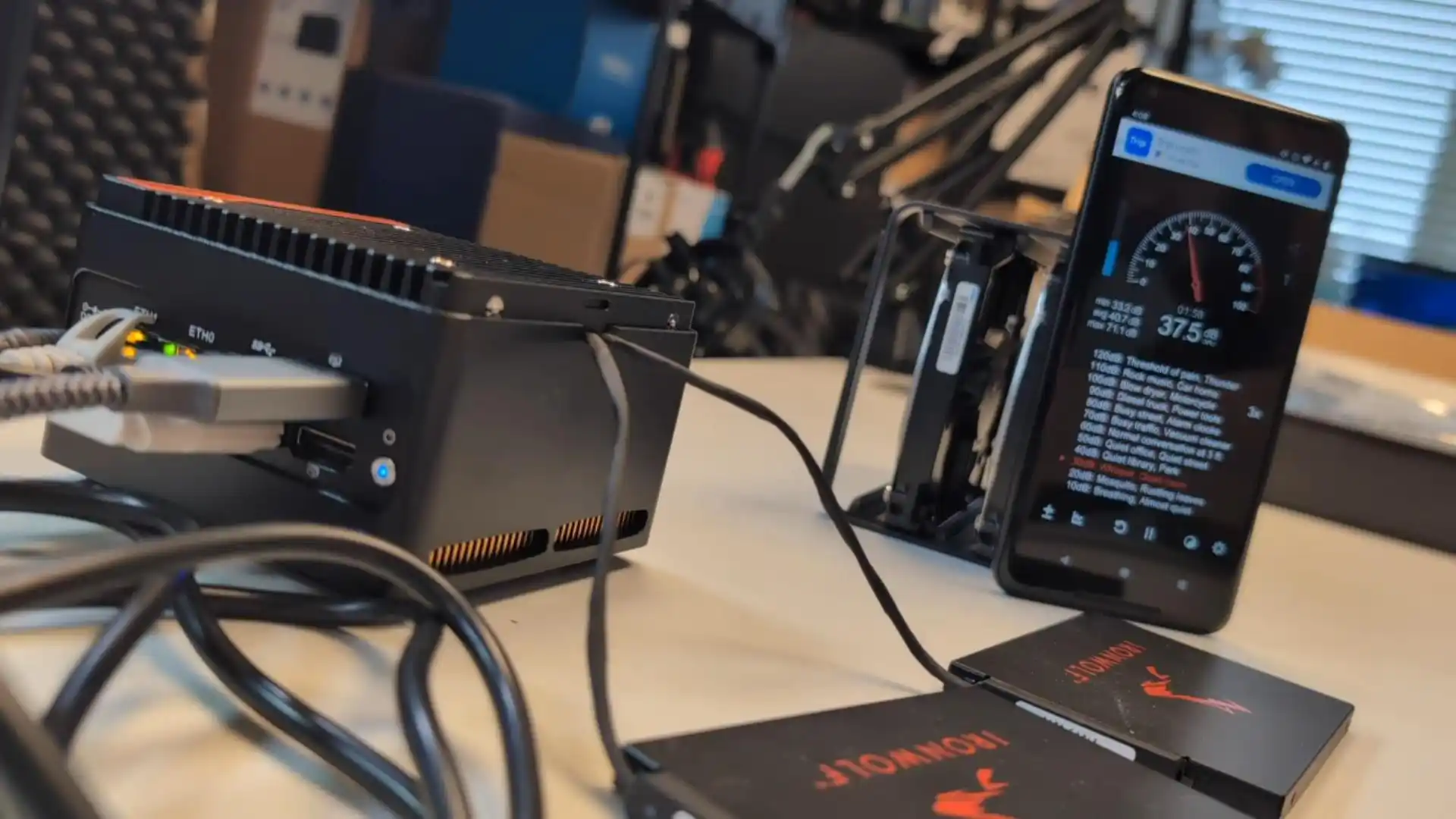
Temperature Measurements:
- CPU Peak (VMs & SSD Reads): 40°C (with fan)
- SSD Peak (Stock Thermal Pads): 65°C
- SSD Peak (Improved Thermal Pads): 55°C

The large aluminum heat sinks and internal fan handle CPU heat effectively, but a lot of this comes down to the CPU being already low-powered to start with, as well as the speed limit of 3×1 on each bay – sorry to keep repeating this, but it’s important!). Early PLEX performance testing was very good! I tested the streaming of a 100Mb 1080p file, a 60Mb 4K HEVC File and an 8K File. I will be going into more detail on the PLEX performance (especially the hardware transcoding later on, via PLEX PASS) later on via the YouTube channel, but my early testing was very good and the CPU use on these single connections was very good (even with Software transcoding too).
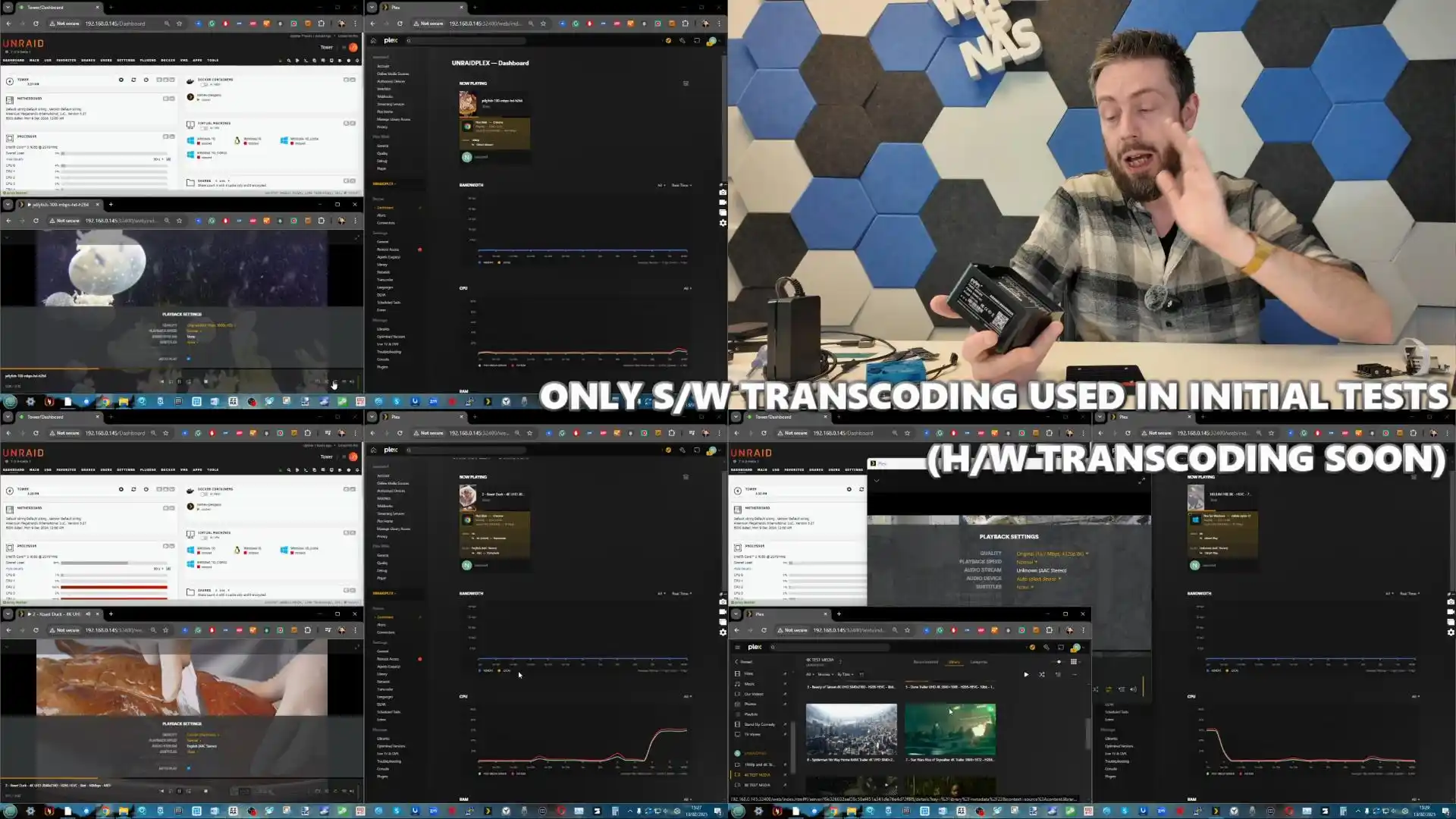
CWWK x86 P6 NAS Review – Verdict & Conclusion
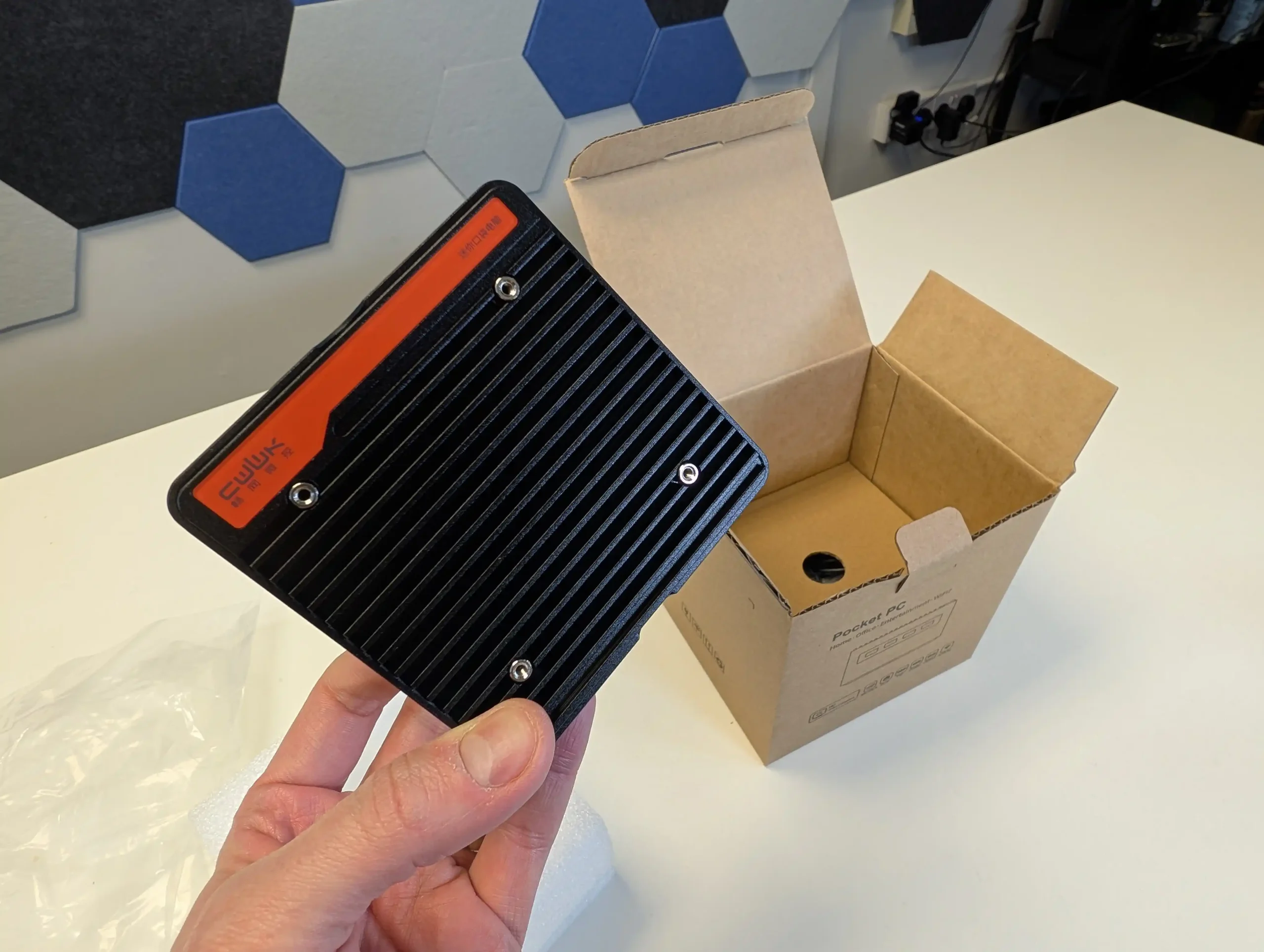
The CWWK x86 P6 Pocket SSD NAS offers a compact and efficient solution for flash-based storage, virtualization, and media streaming, with strong CPU performance and reasonable power consumption. It excels in scenarios such as running multiple VMs, hosting containers, and acting as a Plex server, thanks to its Intel N355 processor and dual 2.5GbE ports. However, it has notable drawbacks, including limited PCIe lanes, unconventional SATA expansion, and only two USB ports, which may restrict expandability. That said, the SATA implementation, while unusual, is understandable given the space limitations of the compact design, and it provides an option for low-cost storage expansion. Additionally, the barrel power input instead of USB-C feels outdated, and thermal pads provided for SSDs are insufficient, necessitating upgrades for long-term reliability.
The lack of 10GbE networking is a missed opportunity, but users can add 10GbE via M.2 adapters, albeit at the cost of an M.2 slot. The N355 version offers significantly better performance for multi-tasking and VMs compared to the N150 version, making it worth the additional cost for power users . In conclusion, the CWWK x86 P6 is best suited for tech-savvy users who are comfortable with DIY upgrades and minor hardware adjustments. It offers good value for VM hosting, containerization, and high-speed storage tasks, provided users are aware of its limitations and willing to work around them.
| Pros | Cons |
|---|---|
| ✅ Compact and portable – Small 100x100x58.5 mm size with a durable aluminum chassis. | ❌ Limited PCIe bandwidth – PCIe 3.0 x1 per M.2 slot restricts maximum SSD performance. |
| ✅ Good multi-VM performance – Handled three VMs with low CPU utilization (under 50%) and stable performance. | ❌ Only two USB ports – Limited connectivity for peripherals and OS boot drives. |
| ✅ Dual 2.5GbE ports – Supports link aggregation for up to ~550 MB/s throughput. | ❌ Barrel power input – No USB-C for power delivery, limiting modern power supply options. |
| ✅ Reasonable power efficiency – 18W idle, 34–35W under heavy load with four SSDs and three VMs. | ❌ SATA support requires adjustments – JFPC1 cable solution is unconventional and may need BIOS tweaks. |
| ✅ Expandable via M.2 adapters – Supports M.2 to PCIe, OCuLink, or 10GbE adapters. | |
| ✅ Effective cooling for CPU – Integrated aluminum heat sinks and internal fan kept CPU below 40°C under load. | |
| ✅ Good media streaming performance – Smooth playback for 1080p, 4K, and 8K files during Plex tests. | |
| ✅ Support for up to 48GB DDR5 RAM – High memory capacity for VMs and containers. |
| Where to Buy? |
📧 SUBSCRIBE TO OUR NEWSLETTER 🔔
🔒 Join Inner Circle
Get an alert every time something gets added to this specific article!
This description contains links to Amazon. These links will take you to some of the products mentioned in today's content. As an Amazon Associate, I earn from qualifying purchases. Visit the NASCompares Deal Finder to find the best place to buy this device in your region, based on Service, Support and Reputation - Just Search for your NAS Drive in the Box Below
Need Advice on Data Storage from an Expert?
Finally, for free advice about your setup, just leave a message in the comments below here at NASCompares.com and we will get back to you. Need Help?
Where possible (and where appropriate) please provide as much information about your requirements, as then I can arrange the best answer and solution to your needs. Do not worry about your e-mail address being required, it will NOT be used in a mailing list and will NOT be used in any way other than to respond to your enquiry.
Need Help?
Where possible (and where appropriate) please provide as much information about your requirements, as then I can arrange the best answer and solution to your needs. Do not worry about your e-mail address being required, it will NOT be used in a mailing list and will NOT be used in any way other than to respond to your enquiry.

|
 |
Minisforum MS-02 Ultra - WHO IS THIS FOR??? (The First 48HRs)
Why People Use TrueNAS, UnRAID and Proxmox to Turnkey NAS (Synology, QNAP, etc)
Why People Prefer Turnkey NAS vs TrueNAS, UnRAID and More
The Top 5 Mistakes NAS Buyers Make
Top 5 PLEX/Jellyfin NAS of 2025
Seagate Ironwolf vs WD Red NAS Hard Drives
Access content via Patreon or KO-FI





Discover more from NAS Compares
Subscribe to get the latest posts sent to your email.


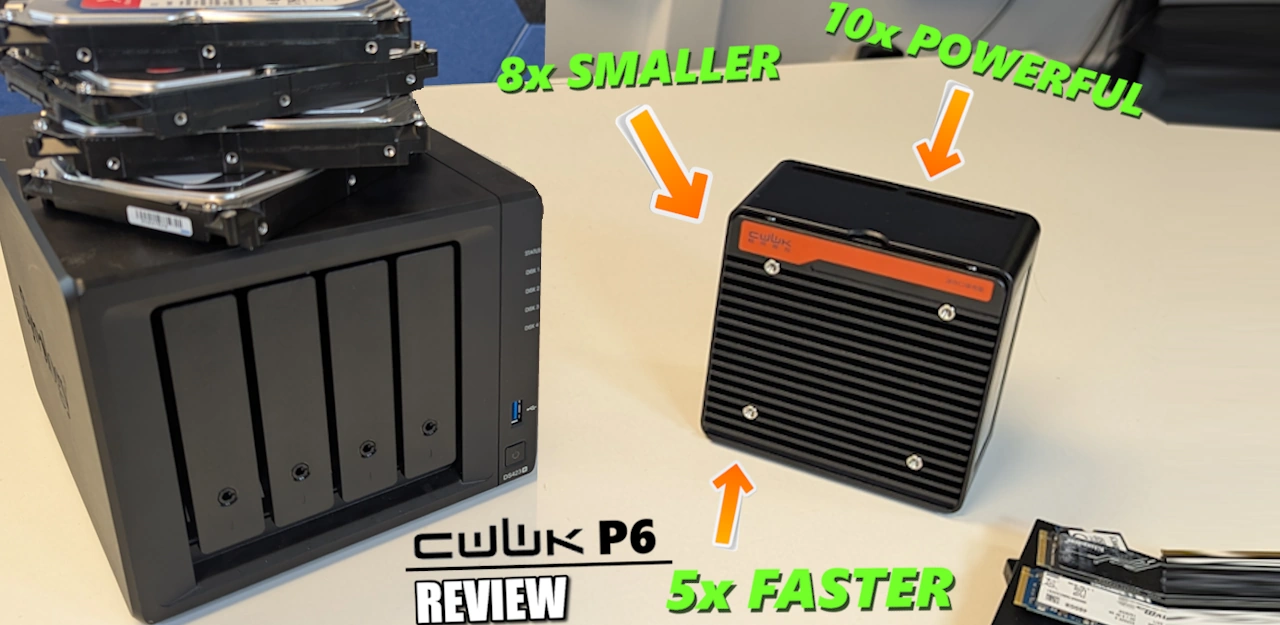
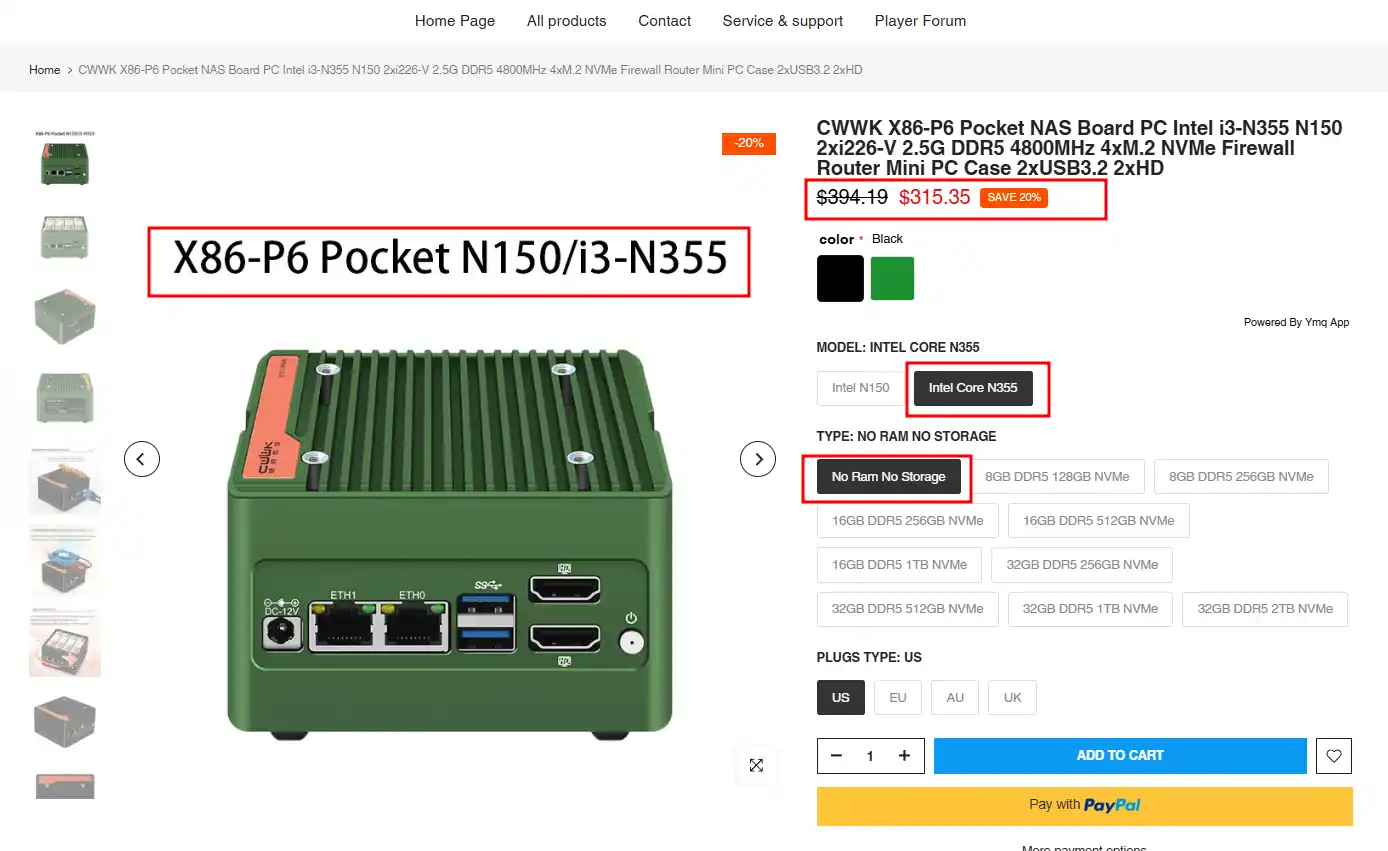



I love this guy’s accent and mannerisms, it just explained a reference that was said in a “therussianbadger” video (his KF2 vid)
So not only did he explain what he was getting at in the video, but also gave context to something on the complete other side of the internet (what “nickers” means)
REPLY ON YOUTUBE
I really want to see you use that adapter on a mini-pc, and close the case… including whatever case modifications are involved. Will the ribbon cable fit through a tiny gab between a couple flush panels?
REPLY ON YOUTUBE
oh i have one with intel 305, 32gb ram ….works like a charm. Synology bye bye
REPLY ON YOUTUBE
1 byte = 8 bits (not 10)
REPLY ON YOUTUBE
reading and writing drive test isnt a great test for a 10GBE NIC. its good for testing drives.
you would throttle due to read and write speeds of the drives before reaching theoretical networking speeds.
REPLY ON YOUTUBE
the untapped power of the Pcie connector.
REPLY ON YOUTUBE
A lot of small talk, but never said where for example 3,3V power supply is coming from (the adapter itself provides data only)
REPLY ON YOUTUBE
seagulls <3
REPLY ON YOUTUBE
Thanks for all the things I’ve learned!
REPLY ON YOUTUBE
Chang Wang?
REPLY ON YOUTUBE
Menudo hdgp.
REPLY ON YOUTUBE
Did you manage to install wifi7 ? Also sis wifi work with free nas they recommend you use?
REPLY ON YOUTUBE
Why is there no mention of the fact that the top of the case (the heatsink) does not shut properly when the SATA cables are plugged in. Does this not make the SATA cables almost unusable in real world scenarios?
Have you heard of Brainchips neuromorphic M2 card ?
REPLY ON YOUTUBE
I dont think you can run the 10g ethernet adapter board in one of the 4 m.2`s as they are just single lane. you`d neet to plug it into the mainboard m.2 slot loosing all your other m.2 slots.
REPLY ON YOUTUBE
Wow, i really want this mini cute with nvme 22110…
REPLY ON YOUTUBE
I wish they have one for thunderbolt
REPLY ON YOUTUBE
Now that the The Beelink ME mini 6-Slot is available there is no point buying this crap… I have both and the beelink has absolutely no hardware issues like cwwk and it offers 6 nvme slots.
REPLY ON YOUTUBE
Pity it wont work truenas over proxmox. Pool fails the very moment you start writting files.
REPLY ON YOUTUBE
Hello! How much storage capacity does each of the NVME connections support?
REPLY ON YOUTUBE
I haven’t had a good experience with my unit, it feels solid, cpu performs quite well. But sadly when i put my, admittedly rather high power, WD SN850X 4tb SSD in the slots i’ve had nothing but trouble. It keeps dropping the SSDs, only way I could get it reasonably stable was to remove 2 of the 4 SSDs i had installed. I’m not sure if it’s because my drives are too high power, I don’t have lower capacity or lower power (non dram & QLC instead of TLC) to test. Going to try the same drives in a TerraMaster F8 SSD Plus I bought as a replacement.
REPLY ON YOUTUBE
Can the MGA1 run Meganex 8K Vr?
REPLY ON YOUTUBE
I contacted with seller by following your purchase link. The seller said the adapter supports only x1 lane which is sad for many people who use old pcie 3.0 GPU.
REPLY ON YOUTUBE
Thanks a lot for your great review! It helped me a lot with my decision, which mini pc to buy..
REPLY ON YOUTUBE
I tested the P5 variant of PC and had some major issues.
TureNAS Baremetal
256GB – OS
3x1TB – RAIDz1
Proxmox
256GB – OS
3x1TB – ZFS
The raid array would error out when sending large amount of data (120GB) to it.
I wonder if they figured out what was wrong with it on the P5 and fixed it on P6.
Nice small package, x86 much better support and yes the NVME do run HOT.
It would be good for the video to show similar test instead of just testing individual drives, if this is to be a NAS most people would have it in some sort of an array.
REPLY ON YOUTUBE
Thanks
REPLY ON YOUTUBE
I wonder if these would work if mounted additionally on a Quad oder Dual NVME M.2 riser card?
I have a system with seemingly plenty of resources here: Server/WW board with some x16 gen3 slots.
Yet, I don’t want to waste entire x16 slots for a single x4 card like a USB 3.2 2×2 oder 10G Network Adapter.
I don’t find the diverse riser card and bifucation cards (x16 to x4x4x4x4 and the like) I find on the net that much convincing.
So if I could add ar least such an 10G LAN Adapter to one of my NVME x4x4x4x4 cards, it would spare me a lot of room and also having to care for additional wiring.
I could also use a small x8 to 2x m.2 riser card to add one ore two of these 10G LAN Adapters.
REPLY ON YOUTUBE
I miss Seagulls so much, love to hear them in the background. Reminds me of home
REPLY ON YOUTUBE
Can you use the wifi m key slot for storage?
REPLY ON YOUTUBE
lol 30w
I have an HP prodesk mini g6 with an i5-10500t and 7 SATA SSDs – it consumes about 30w
REPLY ON YOUTUBE
CWWK are Chinese. They won’t be getting my money until their government changes.
REPLY ON YOUTUBE
I was looking at buying one without ram and SSD’s. The reviews on their website for this product talk about NVME drive corruption issues and complaints their support team don’t respond.
If you go to their support page, the latest article in the list is from late 2023 so it’s likely they don’t even support it.
Can you share any updates?
Can anyone here who are running these let us all know their experiences? Are you running multiple nvme drives? Did you DIY ram and SSD’s or buy it through CWWK? Any issues so far?
REPLY ON YOUTUBE
10gb rj45 ? Lame. Sfp+ and id buy three
REPLY ON YOUTUBE
this helped me a lot thank you so much!
REPLY ON YOUTUBE
I want to stick one in my Qotom 1U denverton system, and add a gpu for boosting LLM performance.
It’s going to be gen3x2, though.
REPLY ON YOUTUBE
These thermal pads are the new style and are acrually quite perfect when placed directly on a die.
REPLY ON YOUTUBE
I hate segals…
REPLY ON YOUTUBE
Hi, i wanted to ask if a pcie x4 USB c card would work if it was connected to the m.2 to pcie adaptor? Thanks
REPLY ON YOUTUBE
Has anyone tried putting a 64GB SODIMM in this thing? Will it support the extra memory?
REPLY ON YOUTUBE
Good
REPLY ON YOUTUBE
If you don’t have RAID redundancy then you really should not be using these things as a NAS. You are asking for trouble.
REPLY ON YOUTUBE
An update to my post… the second unit died too! Immediately sent it back to Amazon. It’s too bad, I was just starting to like it.
REPLY ON YOUTUBE
My first N355 unit from Amazon was DOA and wouldn’t start at all “BUMMER.”
The replacement unit was satisfactory, and it took everything I threw at it and ended up with 4x 2tb NVMe, 48 Gb memory, and Truenas Scale. It will take a few days of testing, but I’m sure my results will be close to yours.
“Sadly,” Truenas doesn’t support 5gbe usb adapters yet. 2.5 gbe works just fine, but not the 5 gbe usb adapter.
Using a usb 3.0 hub, it was very easy to install Truenas and at the same time connecting a keyboard, fan, installation usb stick.
Time will tell if the investment pays off or not. For now, it’s running without problems.
REPLY ON YOUTUBE
Coming from a decade old four bay Syno NAS, I am considering this as a replacement, combined with a large external drive: I don’t need much SSD space for the things that need speed, all else (mostly rarely accessed, movies) can be pulled from a normal external hard drive. Alternatively, the smallest ugreen with two nvme slots could do the job, too.
REPLY ON YOUTUBE
I’m stuck between this and the GMKTek G9. I like the separate emmc in the G9 so the NAS o/s can go onto that. Does anyone know if the internal M2 key connector for the WiFi card in this one can be used for storage (via an adapter) That would clinch it for me.
REPLY ON YOUTUBE
mine only recognize 1 nvme in the first position. Did you have to config something in BIOS in order to use all 4 slots?
REPLY ON YOUTUBE
So that 6x SATA thing – will that work on an old Intel MacBook Pro to make it into a NAS? Maybe with some additional adapters? ????
REPLY ON YOUTUBE
Geht Wake on Lan ?
REPLY ON YOUTUBE
Geht Wake on Lan ?
REPLY ON YOUTUBE
How would you make this work as a simple DLNA server?
REPLY ON YOUTUBE
How would you make this work as a simple DLNA server?
REPLY ON YOUTUBE
Printables has 3-D files for an external mounting bracket that holds 2 x 2.5″ SSD. I saw the included SATA cables in the pictures, so I guess they work ok.
REPLY ON YOUTUBE
@NASCompares you forgot to review the most important part of a NAS, capacity! I tried running 4 * 4TB drives and had random drives disappearing. Reached out to CWWK and they said I could only run 2 4TB drives and 2 2TB drives so I tried that; same issue. Very disappointing; I sent it back to them yesterday.
REPLY ON YOUTUBE
Also while contacting support they told that this “NAS” support max 2Tb drives are supported. So you can’t have 4x4Tb drives.
REPLY ON YOUTUBE
do the external sata/power connections provide enough juice for conventional HDDs? I like the idea for importing data via the unassigned devices plugin in unraid
REPLY ON YOUTUBE
Tested N355 model. First of all the specs are wrong about wifi m.2 slot. It’s not B-key as it’s written on the box or in specs, it’s E-key and it’s USB (no pci-e lanes).
Second thing – it couldn’t run under some I/O load at all. Using “fio” and writing to all 4 nvme drives simultaneously results in controller error. Even if you write something into one drive, other could fail as well. Likely it’s because of power supply instability of the board, since it happens with different nvme drive manufacturers. So this “nas” could be barely used and only if you remove 4x.2 extension board and use single nvme.
REPLY ON YOUTUBE
Help! My SSDs are recognized when mounted on the adapter, but not when mounted directly on the motherboard. Is this normal?
REPLY ON YOUTUBE
Looking on Aliexpress ive saw this “Xikestor PCIE to Dual 10GbE + Dual M.2” Looks to have 2 10GbE and 2 nvme slots which looks good for a compact nas build… I wonder if its any good and what chipset it uses for the network ports!
REPLY ON YOUTUBE
So what is the type of 2nd m.2 slot for wifi? Spec says it’s B. Here it’s stated it’s E. Did someone tested it?
REPLY ON YOUTUBE
Tried coral – doesn’t work and is not detected at all
I have one with n100. Cool hardware, but no stability. Freezing every 20 hours or so. Probably garbage BIOS
REPLY ON YOUTUBE
I hope the E-key WiFi slot can, with an adapter, be used for an extra 2230 SSD. I’m seriously considering this for TrueNAS with a VM running Home Assistant and I’d like to be able to dedicate the 4 full length M.2 slots to my NAS pools with the OS installed on a 5th device. I suppose as an alternative I might be able to boot off an attached SATA drive, as long as there are no BIOS issues, but that’s a bit messier because it adds stuff outside of the case.
A nice touch that CWWS could have added would have been a set of 4 simple fan brackets for the top fan. 70cm isn’t particularly standard and it would have been nice to have an easy route to adding a 3rd party fan. Noctua tends to be my go-to solution and being able to use an 80mm or 92mm quiet fan would be nice. I’d probably cobble something up myself if I go ahead and get one of these units & maybe that’ll be my final excuse to go and buy myself a 3D printer. (Researching that is a whole other internet rabbit hole I’ve been in constant danger of falling down for the last few years.)
REPLY ON YOUTUBE
Уже едет ко мне такая штука.
REPLY ON YOUTUBE
Where would you put the NAS os on this thing? Do you put it on the array or on a usb-drive or?
REPLY ON YOUTUBE
Yeah but 4x12TB spinning rust is actually affordable.
REPLY ON YOUTUBE
Rude, you have MY exact same Synology NAS on your desk, point at it, and say it’s obsolete! ???????????????????? Too Funny!
On the SATA capabilities you so eloquently played down, they can still be a deal. I bought a box of refurbished Seagate 16TB eXos drives for a bit under $100 each x 24. Granted 3 were defective, but still a deal.
REPLY ON YOUTUBE
Very interesting long form video. Not boring at all.
REPLY ON YOUTUBE
I would love a 8x NVMe alternative with vertical slots – considering this model ones horizontal –
REPLY ON YOUTUBE
Your audio is terrible fyi
REPLY ON YOUTUBE
You seem to be very insistent that you believe this would be better with a USB-C power supply rather than a barrel plug. I cannot agree.
True, USB-C is the modern way to go, and there are a lot of USB-C chargers around, but the problem is that USB-C is a standard plug but not a standard cable. Different cables can have different capabilities, and it is easy to end up using the wrong cable without realising it and spending a long time trying to work out why there is not enough power being supplied. With a barrel plug, if the plug fits then the power should be able to be delivered.
REPLY ON YOUTUBE
Have you tested the GMKtec mini NAS? If not I would love to see a comparison of this vs the CWWK.
REPLY ON YOUTUBE
Is there such a thing as a USB-C to Barrel power adapter. How does one get the required Voltage & 60 watts from a standerd USBC power supply?
REPLY ON YOUTUBE
Who cares about a little fan noise my ASUS laptop runs 100% of the time, Just becoms part of the Backround. My Tinnitus is far more annoying. People just Like to Complain.
REPLY ON YOUTUBE
Always brilliant
REPLY ON YOUTUBE
Does it work for Apple products ??
REPLY ON YOUTUBE
Thermal pads??? Seriously? They make contact and work.. perhaps they are the appropriate for the design of the machine.
REPLY ON YOUTUBE
@NASCompares , Internet searches report to not to use UNRAID via USB dongle at risk of array corruption, is this valid? and what are any other options for USB-bootable NAS software?
REPLY ON YOUTUBE
Ouch… 18W idle even with 4 SSDs…. is quite a LOT, compared to a similarly sized N100. I guess they don’t have all the idle optimalizations dialled in yet.
REPLY ON YOUTUBE
Thanks for the video – I was just in the process of looking into this exact machine (N355). Exactly everything I needed to know
REPLY ON YOUTUBE
This or the gmk g9?
Cant decide!
REPLY ON YOUTUBE
Does anybody have the hardware tree for this? Mayde `lshw` output?
REPLY ON YOUTUBE
I always enjoy your videos. Lots of great information and very little nonsense. The seagull interlude just put this one over the top for me. Flipping brilliant and I could not stop from laughing.
REPLY ON YOUTUBE
No ECC = Absolutely no buy ! Needs ECC support and 10GBE to be relevant
REPLY ON YOUTUBE
Main difference is M2 or oculink is damn cheaper then thunderbotl to pci-e interface and not a possible problem with compatibility… Only problem is not enough m2 slots.
REPLY ON YOUTUBE
Isn’t the AOOSTAR TB4S-OC also a viable option?
REPLY ON YOUTUBE
Chinese… no thank you
REPLY ON YOUTUBE
Are their options in the BIOS for In-Band ECC? I know this CPU doesn’t support it but I have seen it offered with the N97 CPU which does.
REPLY ON YOUTUBE
Chinese pottery ????
Chanwang….
Are you serious?!
REPLY ON YOUTUBE
Do those SATA cables only support 5V for 2.5″ drives or also 12V for 3.5″ drives? I would like you to focus a bit more on BIOS options in your reviews as in one screen I saw Thunderbolt mentioned…which Alder Lake N, Amston Lake, Twin Lake don’t have…
REPLY ON YOUTUBE
Looking to use this with the amd atomman…. The 7600m is weak for the 7945 and they forgot to add anything above 10mbps usb
REPLY ON YOUTUBE
What OS can be installed on this pls?
REPLY ON YOUTUBE
31W is kind of high for 4 ssd, i got similar result with 4×3.5hdd….
REPLY ON YOUTUBE
If you get hands on the n150 system, i’d like to know the difference in idle power between the two versions. Idle Power seems a little high for the cpu and expected controller.
REPLY ON YOUTUBE
what web software is the dashboard management
REPLY ON YOUTUBE
Why would you do a noise test with music in the background?
My Samsung EVO M.2 SSDs are 50C on idle, probably would not be a good idea here.
REPLY ON YOUTUBE
I use my NAS as a perma-backup…often replacing drives and placing them in USB multi-drive boxes for final storage. Do you have any concerns about the lower TRWs of NAND Flash memory cells over mechanical hard drives for the long term use of SSDs in a NAS function where rewrites could prove quite frequent over a network of users?
I avoid using SSDs under certain scenarios, (My computer’s download & documents folders, for example, are on a mechanical drive, a habit adapted after losing data from critical SSD fails)
REPLY ON YOUTUBE
Hello,
is it possible to equip the internal slot, which is intended for the WLan module, with an SSD? So that this could be used as a boot drive and the other 4 slots could be used for data SSDs?
REPLY ON YOUTUBE
given the same material and mounting pessure you want the thinnest pads. The thinner the pad the faster and better the thermal transfer to the the heatsink. It’s why thermal paste is used on gpu’s and cpu’s instead of pads.
REPLY ON YOUTUBE
Barrel connection is potentially much more durable than usbc.
REPLY ON YOUTUBE
thinner thermal pads = lower heat transfer resistance
REPLY ON YOUTUBE
USB eDP is Possible?
REPLY ON YOUTUBE
I cannot trust these items directly from China without a reputable outside retailer.
REPLY ON YOUTUBE
Any known adapter card for Lenovo Ideapad 320 internal wifi M.2 card to RJ45?
REPLY ON YOUTUBE
No ECC no sale 🙁
REPLY ON YOUTUBE
Anyone tested vidoe editing on this?
REPLY ON YOUTUBE
I would rather have a proper dc connection over usb-c. But they could’ve at least recessed it into the chassis, so the plug was stabilised and “clicks” in. Because there’s a reason they kept inventing newer power connectors. It’s very janky and insecure. And thr main power connector.for a nas, SHOULD be locked in. Omg. How can they not just do it right.
REPLY ON YOUTUBE
Dang. I now need to get s nas , again.
REPLY ON YOUTUBE
But it is Chinese.
REPLY ON YOUTUBE
2 x 2.5Gb port right?
REPLY ON YOUTUBE
For the idle power, I noticed that some mini PCs have ASPM disabled in BIOS under PCI Express configuration. See if you can flip it on.
For the powering, there are converters from USB type-c to barrel, but they are typically for laptops and output 19.5 – 20 V on the barrel side.
REPLY ON YOUTUBE
I had the same i3-N355 where i add a DDR5 4800 32GB RAM from Kingston and SSD M2 2TB from Lexar and my system keep resting time to time. I don t understand way?!
REPLY ON YOUTUBE
“I hate seagulls!” Good review.
REPLY ON YOUTUBE
I brought one of these to use as a travel NAS, and slapped in a WIFI7 card, it works a treat! … Not it has no holes forthe antenna’s.. but the huge-ass label on the front (see 0:30) is just plastic, and eash to drill a couple of holes through, it looks as ugly as hell, but works really well.
REPLY ON YOUTUBE
its cool, just the lack of 10Gb Ethernet is a bummer
REPLY ON YOUTUBE
The links for the product in the description don’t work… @nascompares
REPLY ON YOUTUBE
Get well mate! Love your videos!
REPLY ON YOUTUBE
What operating system is possible ?
REPLY ON YOUTUBE
I am laughing hard when I see the enthusiasm on your new toys, not understanding that the big old boy Synology is not a toy. You have no worthy software for your new toy to back it up as a replacement. Any open source software will be long gone when Synology will still stand. There is the price, not in the hardware. Hardware is nothing. If you have never restored a crashed server to a new bare metal, using one of your backups captured with Synology software, if you never restored multiple versions of some important files when those files have started being corrupt, you can’t understand value. If Synology doesn’t hold value in front of your toy, than this new toy will have a very short life as well hahaha. No business will have this toy filled with SSD’s in their environment. I think Synology is not for you, I can understand that much. I’ve got at least 10 solid reasons for Synology can’t be replaced by a toy.
REPLY ON YOUTUBE
i’ve got a ROG Strix X570-E Gaming (which will end his life under proxmox) that i bought in early 2020, the last bios update was 2024/11/01, does these mini pc/nas ever had a bios update?
REPLY ON YOUTUBE
You didn’t mention what OS this runs ? Someone in the comments mentioned unraid? Can the M2’s run Raid 1 or Raid 5?
REPLY ON YOUTUBE
I’m only 3min in and that noise is driving me crazy. I hate he doesn’t tell us upfront why it is there.
REPLY ON YOUTUBE
Ad MMC boot, 10Gbe SFP+, this would be gold. would love to see CWWK try making 1U devices for 10 inch mini racks
REPLY ON YOUTUBE
They are really good value, I have a N100 mini PC it cost a lot more as a soon to be a home cloud server. 2 2.5gb nic, wifi 6b, 5000gb hd and 16gb ram great endpoint PC too.
REPLY ON YOUTUBE
Using an M2 to ethernet adapter, you’re still stuck with the bottleneck connecting all 4 M2s to the motherboard
REPLY ON YOUTUBE
I just bought an N97 mini pc and it’s fantastic
REPLY ON YOUTUBE
That bottom fan is a concern … WHEN it fails, how are you going to replace it? It doesn’t look like a standard size and it’s integrated into the heatsink.
REPLY ON YOUTUBE
12v barrel jacks do allow easy integration with external 12v PSUs with battery backup. A cheap UPS solution without the losses of AC/DC & voltage conversion.
Currently designing one to go in a location with plenty solar so could go entirely off grid power.
REPLY ON YOUTUBE
Isn’t the idle power too high? Those CPUs are meant to be low power.
REPLY ON YOUTUBE
why don’t you try the odroid h3/h4? they are the only ones with low consumption comparable to the zimaboard/zimablade?
REPLY ON YOUTUBE
i love seagulls ???? would be so nice to have them and the sea here in Paris ????
REPLY ON YOUTUBE
Thanks. Please Get Well Soon ! ????
REPLY ON YOUTUBE
Thinner thermal pads are better not worse ????
REPLY ON YOUTUBE
Hi just in time I was planning to take this device to try with proxmox various solutions:
1- Ai via m.2 coral google edge tpu card.
2- qnap qtscloud on vm
What do you think it could handle the load with the corals in parallel?
REPLY ON YOUTUBE
Why do you care about individual disk performance if one cannot get it out? SSD NAS without 10GBe just don’t make sense to me.
REPLY ON YOUTUBE
i must have missed it:
is there integraded storage for the OS?
Is that this not really ssd emc rom stuff?
REPLY ON YOUTUBE
How would you power the NVMe to PCI-E device if you used that adapter? Even if the 60W barrel connected “PSU” provides enough power, I didn’t see where there are power cables…
REPLY ON YOUTUBE
Man I hope we get cheapo high capacity reliable ssd soon
REPLY ON YOUTUBE
I have the X86-P5 model of the same chassis, unfortunately the fan on the former model is incredibly noisy, which is throwing me off.
There’s one thing that you didn’t mention though which is how you can easily adapt an M.2 converter on the Wi-Fi slot to put an extra 5th nvme. You can possibly even make it fit taping it under the extension board.
Overall there’s a few trade-offs on these price points, as seen from the last model they look more like prototypes being sold as finished products and will always lack the polish of a more stable and expensive brand. It’s great for a lab or first for a first NAS to evaluate if you’re into the world of self hosting though.
I’ve paid 130 GBP for the x86-p5 and it definitely helped making me see what I could do with it, but now I’m looking into a more polished and safe solution, maybe waiting for a price drop of the terramaster f8 or the new lincstation n2. For low power users the new processor at higher power usage are probably not a good choice anyway.
REPLY ON YOUTUBE
Again Alder Lakes-N CPUs have 9 PCIe lanes. This board cannot have 2 usb3, 2 Sata, 2 NIC, 1 wifi6, 4 pci NVM same time. It is 11, but there are 9 total lanes. So I think there are total 2 lanes for 4 NVM. Half of PCIe3, or 1 PCIe2 for each NVM
REPLY ON YOUTUBE
Switch out 2 nvme for an oculink or usb4 and then come up with some cheap hdd storage bays and game over.
REPLY ON YOUTUBE
The seagulls are still saying they want 10gb, full pcie lane bandwidth speeds and decent cooling
REPLY ON YOUTUBE
This is a Chinese brand so.. ehh.. I’ll pass.
REPLY ON YOUTUBE
i have 2 of them in a proxmox cluster (+1 raspberry qdevice and pbs), they are fantastic and also 5 nvme in one of them, really love them.
REPLY ON YOUTUBE
Also, happy to see more and more portable solutions for people that need it or need to save one physical space in wherever they work. Def kinda hoped for more ports but it is what it is.
REPLY ON YOUTUBE
From what I understand, you don’t want your thermal pads to be thicker because the more material you have the less heat transfer is going to happen to the heatsink. Am I mistaken here?
REPLY ON YOUTUBE
I would like to see Plex tests.
REPLY ON YOUTUBE
Wait I just bought a GMKTec G9 after seeing your video, should I have bought this 🙁
REPLY ON YOUTUBE
I was missing the seagulls! I mean, really! It’s basically one of the distinctions of this channel (aside awesome and detailed reviews!).
REPLY ON YOUTUBE
So has anyone used these specifically for media (plex).. ?? I use a mini pc now for the containers with a 2 bay old synology nas mounts. I let the minipc run plex and my -aar containers. I suppose I can do the same with this.. separate “compute” and use this for the storage of my media with libraries mounted. “hmm thinkin thinkin thinkin”
REPLY ON YOUTUBE
What’s the best approach to hook up external HDD to this? I don’t mind a separate enclosure but would like to have a Raid 5 array for bulk storage.
REPLY ON YOUTUBE
Those seagulls took me OUT ????????????????????????????
REPLY ON YOUTUBE
Seagulls suck.
REPLY ON YOUTUBE
Ok 18 Watt in Idle is high. I had in the past an microATX mainboard with an AMD Ryzen 7 5700g in a fully passive Cooled Media PC enclosure with 6 SATA SSDs, 1 RX540, powered via a 90W 12V PicoPSU and this system Pulled only 5W on idle and the drives were all in a Raid 6 configuration managed over the mainboard. I mean yeah under load this thing was able to hit 80W i used this system heavily and ended up pulling close to 70W constantly. So i decided to buy something more capable, but it was an efficient system. My system now uses more power on idle, but is more efficient with increasing load.
REPLY ON YOUTUBE
Got two of them running non stop for two months. First one as a nas, second one for containers. This setup is flawless and takes no space. Really appreciate theses.
REPLY ON YOUTUBE
there were …typec to barrel adapters
REPLY ON YOUTUBE
Seriously?! I ordered the P5 N305 version in late December and got it like two weeks ago. Now you’re telling me that they finally released a variant with a newer CPU just after I ordered that? Just my luck I suppose.
REPLY ON YOUTUBE
Someone speaking English and using Centimeters right from the start without mentioning inches, this is new for me. ^^
REPLY ON YOUTUBE
Can’t decide between this (n100 version) and Nucbox G9 for a Home Assistant/Frigate/Jellyfin. G9 has LPDDR5. But this one seeminglyhas better build quality. Wonder how they compare on noise.
REPLY ON YOUTUBE
From my reading the SATA connectors worked ok on the predecessor X86-P5. Though you had to route those special cables and organise a chassis. I think they retain the ports as the N series cpus give them for free, not taking a scarce pcie lane.
The P5 had a variant/upgrade that added 4xUSB2 on the blank rear panel. There were headers already on its motherboard.
I’m intreaged if they’ve changed more than the cpu on these, as the other generations (P1/P3/P5) got board changes as well as the cpu.
For those who fancy 10gb cwwk do have a couple of devices with 2xSPF+. Those lean into router solutions though without the M2 array functionality.
REPLY ON YOUTUBE
puts any synology to shame
REPLY ON YOUTUBE
Excellent review. Thank you. Looking forward to the Minisforum MS-A2 review with 10g and several PCIe-4 x4 slots.
REPLY ON YOUTUBE
Great product. Loved the quick review.
REPLY ON YOUTUBE
I am interested in the sata cables. Will it work someday?
REPLY ON YOUTUBE
I would have thought the thinner thermal pads the better. They don’t conduct heat as well as something like aluminium just better than air. So you want the smallest thickness possible that still eliminates all air gaps.
REPLY ON YOUTUBE
Intriguing. Slap four 8 TB drives in there with 48GB of ram, and you are sitting at 24TB of relatively quick storage in a tiny package using truenas and raidz1.
REPLY ON YOUTUBE
Thermal pad thinner is better in heattransfer but most ssd are not flat and the stuff on there are not in same height
Thin pad might causing issue
REPLY ON YOUTUBE
I’m thinking of making the R2max into a NAS because it has 2 x 10GB network. Only 2 NVME though. Unraid?
REPLY ON YOUTUBE
its 2025 10GB is mandatory
REPLY ON YOUTUBE
I bet you could set up a POE camera or motion sensor, connect it with an auto-shotgun, and it would solve your seagull problem.
REPLY ON YOUTUBE
Does it have USB4 for a DAS connection to Apple?
Considering how much SSD cases cost for Apple, this is like an expensive SSD case with a free Intel CPU for transcoding.
Given the heat issues probably would not want to stack an Apple Mac Mini directly on top?
The 8 CPUs would be good for DuckDB.
REPLY ON YOUTUBE
????, thank you , i was wanting review of this device for awhile now.
It was also listed as Brand SIENSNET and SPARKFLY on Amazon.
REPLY ON YOUTUBE
weeeeelllll… 300 no storage, no memory, I might as well get the baseline mac mini. 600 bucks 2-3x the power.
REPLY ON YOUTUBE
Is that a NAS in your pocket or are you pleased to see us ?
REPLY ON YOUTUBE
I would love something like that but fanless and with less idle power draw…
REPLY ON YOUTUBE
man, I really love the build quality and design on CWWK gear. there’s something a little retro about it that I really like and the entirely metal casing makes me happy. (plus good for heat dissipation.) my one real criticism? GIVE US 10GbE, YOU COWARDS
REPLY ON YOUTUBE
I like ssd but would like to see atleast two 3.5 drive bays so i could have larger capacity.
REPLY ON YOUTUBE
7 minutes after video upload, AliExpress took down the link for the N355. Price increase inbound.
REPLY ON YOUTUBE
I need this with 6 slots. a bit bigger would be OK.
REPLY ON YOUTUBE
Wisebuy reviews tested a m.2 to 20gbe card with the same controller chip and got 1.1GB transfer rates on his mini pc.
https://youtu.be/vyS31rqOPFc?si=ZaWt1qJHdAIOhlhq
REPLY ON YOUTUBE
Hi. What about the delay? And what do you think if i use one with m.2 gen 4 slot on my Minisforum HX99G?
REPLY ON YOUTUBE
Can you test if it is possible to add a egpu to something like a ugreen nas running truenas via PCIE to Oculink in order to provide extra power for transcoding AV1 and running ollama
REPLY ON YOUTUBE
These adapters are always quite interesting to think about.
Personally i had this idea of using m.2 sata adapters, the easiest foolproof variant is one, which accepts 2 sata data and 1 sata power for 2 m.2 sata drives. There are also 3 drive adapters, which probably use raid/jbod systems to show 3 drives as 1. Tho i think that might cause more problems, having separate sata cable for each drive is foolproof.
Then you also add a pcie adapter, which gives you extra sata ports. With an x4 slot, i think you can easily convert that into 20 sata ports or more.
I personally like to keep m.2 slots for fast nvme drives, considering DirectStorage and improved access times for newer games.
REPLY ON YOUTUBE
You are only running this at 4x 3.0 which isn’t going to exceed USB4 you need to ht 4x 4.0 use GPU-Z to check . My Beelink GTR7 Pro uses PCIE Gen 4 however I have tried to and both only show 4x 3.0 why I don’t know?.
REPLY ON YOUTUBE
What would happen if we would add an Oculink M.2 adapter to a Synology NAS? Like an 1821+. Would DSM recognize it and allow us some enhanced AI Facial recognition or DVA in Surveillance station?
REPLY ON YOUTUBE
will this adapter installer in UM773 lite anyone??
REPLY ON YOUTUBE
Thr video I’ve hoped someone would make, I’ve had these adaptors since November and i haven’t had the time to try it myself. I purchased a few on AliExpress. Thanks for covering this topic. How do i check if my beelink gtr7 pro 7840hs mini pc has rhe pcie4? Thank you ❤
I purchased an m.2 to Oculink extension so i can keep the mini pc closed and adds a socket outside the mini pc. However some claim wirks no issue a few say the particular ones i chose don’t work and only work with the same manufacturers oculink hardware. ????????
REPLY ON YOUTUBE
What I’d like to see is a drive box with 6 or 8 3.5″ drive slots and a LSI card. that way you can start with a low end system and upgrade – rather than having a USB connection use Oculink
REPLY ON YOUTUBE
Isn’t 64Gb/s
REPLY ON YOUTUBE
Long-winded ????
REPLY ON YOUTUBE
Dodgy audio?
REPLY ON YOUTUBE
Is there such a thing as an ethernet switch that has an oculink uplink? I was thinking it would allow a few high speed devices simultaineously share that 64gb path to a nas.
REPLY ON YOUTUBE
This is not the future, here will you have Thunderbolt 5, all new Macbook with M4 Pro CPU and also some PC’s already have Thunderbolt 5. It gives you 120Gbit bandwith, 80GBit bidirectional.
REPLY ON YOUTUBE
OFFS, please stop using Bytes, it’s for stortage and your bloody 10X multiplication rathern than the correct 8x just is lazy.
REPLY ON YOUTUBE
audio clipping still a thing it seems.
REPLY ON YOUTUBE
?WHY?
I own a Mini-PC with Oculink – so I don’t need this adapter. But I don’t need the built-in Oculink either, it’s just there – and it is completely unnecessarily!
Imagine the setup: Mini-PC, Oculink extender with a graphics card (probably with its own power supply unit…), USB extender and a power supply unit? A huge mess on the workplace. Please consider: WHO WOULD WANT SUCH A THING?
What I would like to have is a PC in a compact case (maybe 3x the size of a Mini-PC, but high enough to fit a graphics card within), with a built-in power supply, 4 x HDMI and 4 x DP (8 connectors, for a total of 4 monitors – never worry about what graphics cable you take along…), 12 x USB3.0, 4 to 6 USB-C, 1x10GB 1 x 2.5GB network.
This would result in a tidy workstation and thermal problems would be much easier to solve than in a Mini-PC!
REPLY ON YOUTUBE
Does it work with Apple Silicon with any m2 thunderbolt adapter ?
REPLY ON YOUTUBE
Isn’t 64 gigabit equal to 8 gigabyte bandwidth?
REPLY ON YOUTUBE
pcie 4.0 nvme to oculink solution might need redriver
REPLY ON YOUTUBE
Need to see you plug this in to an Asustor Gen 3 or Flashstor with Ryzen and see if you can make up for the lack of GPU…..
REPLY ON YOUTUBE
I’d love to see some standardization regarding external pcie connectivity. Right now we have TB, Occulink (x4 and x8 kinds), U.2 over few types of SFF cables and probably few others.
REPLY ON YOUTUBE
Why does he keep using the “N” word?????????????♂
REPLY ON YOUTUBE
How exactly are you going to use that in a mini-PC? You would have to cut a hole on the chassis.
REPLY ON YOUTUBE
Oh so that’s where the N305 went… into NAS motherboards o.o
REPLY ON YOUTUBE
Would it work to install one on my nas and one in my pc to have a direct connection rather than going through my switch?
REPLY ON YOUTUBE
I’m using a Occulink/M.2 adapter with a Dell 7090 SFF running a 6800XT and can play just about any modern game. Use a PCIe M.2 adapter as a riser and then the occulink cable can be run out the back of your PC.
REPLY ON YOUTUBE
No idea what he’s talking about.. Anything in simple English?
REPLY ON YOUTUBE
Using, for example, the PCI adapter and adding a GFX card via occulink would that be beneficial to NAS media transcoding?
REPLY ON YOUTUBE
People, if you’re using such adapters be sure that you can check for PCIe Bus Errors, i. e. that the adapted PCIe Interface and BIOS support PCIe Advanced Error Reporting (AER). PCIe lanes coming directly from a CPU typically support PCIe AER, PCIe lanes generated by a chipset might not. The problems caused by failing signal integrity with PCIe Devices are very, very diverse.
REPLY ON YOUTUBE
Icy dock makes some 5.25 bay adapters that utilize oculink ports
REPLY ON YOUTUBE
i’m hoping to see if something like this can be fit inside a gen3 lockerstore to add graphics to install truenas and run plex
REPLY ON YOUTUBE
Happy New year in 2025
REPLY ON YOUTUBE
The x99 motherboard I use for my homelab setup doesnt have a PCIE slot aligned with the top most expansion bay on my case (nor do many ATX motherboards it seems), so with a 4xM.2 to X16 card in the top slot I can install 2 SSDs, a 10GB SFP+ NIC that is routed to the slot above, and have an extra slot available for future use without touching the rest of the PCIE slots below.
REPLY ON YOUTUBE
I agree with the comments about the ribbon cable, it is terrible. Looks like some basic generic cheap cable. No wonder why someone in comments mentioned lower data rates when installed in miniITX compared to test laying flat on table. Interference is a bi*ch.
On the bright side though, they do sell version of this NIC with micro coax cable which is far better solution for this application. It would be interesting to see comparison between these two outside and inside miniITX case. I bet we would see better numbers.
REPLY ON YOUTUBE
Thank you.
REPLY ON YOUTUBE
Would this work: Thinkcentre 910q wifi slot (e-key) -> a+e key to m-key adapter -> 10gbe adapter (m-key)
REPLY ON YOUTUBE
Be sure to tell ADT-Link to send you new & well packed cables.
REPLY ON YOUTUBE
Would it be worth while using a low-profile gfx card with the PCI slot adapter for some transcoding when using a n305 CPU?
REPLY ON YOUTUBE
Now try that M.2 to PCIe adaptor on a Synology and see if you can get a GPU working?
REPLY ON YOUTUBE
my brain isnt meant for this. Ill come back in like 5 years after I go down the rabbit hole.
REPLY ON YOUTUBE
the landlord special
REPLY ON YOUTUBE
So the slots are not to make toast with?
REPLY ON YOUTUBE
starting out by telling folks they are using soemthing wrong by using the MAIN consumer product it was made for … is not a good take my bro. my mainboard has 5 open m.2 slots and one that is occupied by the wi-fi module , (still building the system) i already got 1 ssd and i plan on filing the others with SSD’s . i’m a gamer that is sick of juggling hard drive space vs fast storage for X game… so yeah bro i’m filling those with storage.
REPLY ON YOUTUBE
Something to keep in mind is that your M.2 slots are bottlenecked by the number of PCIE lanes your CPU and Motherboard support. If you several things like a NVME and 10GE into your m.2 slots and you also have a honking GPU, all of your devices are likely going to be throttled as a result. An i513600K for example has 20 PCIE lanes. Pair that with an RTX 4070ti which eats 16, and you’ve only got 4 left for an NVME, and you’re out of lanes already.
REPLY ON YOUTUBE
I am not using my m.2 slot wrong.
REPLY ON YOUTUBE
dont use a gpu on that adapter
i dont see dedicated 12v
i see fire when the gpu asks for 75w from the m.2 slot
REPLY ON YOUTUBE
PCIe is PCIe is PCIe, my friend. 😀 I honestly don’t know why they went with M.2 keying, since apart from NVMe vs SATA they deliver pretty much _the same thing_ – PCIe lanes. And using a x4-to-6xSATA breakout module is still a better deal than putting ONE (1) SATA disk in it. Just something to remember: those controllers will likely run at SATA-II or even SATA-I, depending on how much you’ve paid – YMMV, you may find better chips to use your M.2 on. Still, if you’re running GbE (while 2.5GbE and 10GbE _cards_ may finally have reasonable pricing, the _switching hardware_ still costs a pretty penny! I can buy TWENTY 8-port GbE switches for what they want for an 8- or 10-port 2.5GbE!), adding even a 4xSATA-I card per PCIe lane is reasonable for HDDs.
REPLY ON YOUTUBE
If your CPU supports _PCIe bifurcation,_ move your GPU to a x1 or x4 slot (a dremel may be useful if you don’t want to buy a riser) and then purchase a 4×4 card that can fit 4x NVMe on the x16 slot. The CPU needs to support this, and there are modes (x8/x8, x4/x4/x8, x8/x4/x4, x4/x4/x4/x4) which may or may not be supported (my CPU doesn’t support the 4×4 config – I suspect it’s due to the iGPU – so I ended up going with x8/x4/x4 for a total of 3 NVMe disks). But if you really need those PCIe lanes – a PCIe x16 card that gives you 4 x4 M.2 sockets is _a wonderful thing to have._ Just take care: this will likely be very awkward to reach and will require angled adapters. But if you have a free x16 slot? That’s potentially 24 more SATA ports…
REPLY ON YOUTUBE
A small ARM PC with 4xGbE that I’m using as a router doesn’t offer any sort of storage except for USB ports and a microSD card slot. If you’ve ever tried running a full-fledged OS on a microSD card, you’ll know that it’ll bite it _in about a year_ (besides being slow as heck). But the two M.2 slots keyed for a WiFi card really helped there! 😀 Actual NVMe storage? Wicked! It really gives you back the power, because otherwise it’s a super-fast quad-core 4 GB machine! Another thing: under Linux, nVidia GPUs really don’t like to run on PCIe that is _not_ hooked to the CPU (the driver hangs on boot). So I moved my NVMe disks to a 4×4 card in the x16 slot, and then used the M.2 to hook the GPU up. May not game great, but AI doesn’t care. 😀
REPLY ON YOUTUBE
I don’t have an M.2 slot, but if I did, I’d use it the right way – being promiscuous.
REPLY ON YOUTUBE
I’ve been trying to do this to my Dell Opliplex AIO 9030, but can’t seem to get it to work.
Want to run PCIE off the NGFF NVME socket so I can turn it into a gaming GPU attached AIO, but I think the BIOS needs to be flashed with a custom image, and that’s a bit beyond my current skill.
REPLY ON YOUTUBE
Nope, full ATX Mobo for me! ????
REPLY ON YOUTUBE
And slow down your video card slot from 16-bit to 8-bit, no thanks.
REPLY ON YOUTUBE
So could you do the x16 slot and add a x16 m.2 expansion card? Then it’s just an infinite storage glitch
REPLY ON YOUTUBE
Semen
REPLY ON YOUTUBE
We need those aye aye options these days.
REPLY ON YOUTUBE
So we start bringing the Apple you using bla bla wrong to the masses too. ????
REPLY ON YOUTUBE
What about on a laptop ????
REPLY ON YOUTUBE
Why would I use my m2 slot for something that is objectively worse all around?
REPLY ON YOUTUBE
I already used my m.2 slots but could probably add a m.2 adapter to the extra PCIe slot for convenience and thereby freeing up one m.2 slot.
REPLY ON YOUTUBE
Any chance that there are SAS adapters for m.2?
REPLY ON YOUTUBE
lol some of these are really dumb. But thanks for The suggestions.
Oh while we are rounding up kinda useless suggestions, what about oculink? That’s one that I have actually seen in the real world and it wasn’t a terrible idea
REPLY ON YOUTUBE
Weird how women sound sexy in that accent but men sound like they were dropped on there head as babies…
REPLY ON YOUTUBE
I feel like 4 lanes of gen 4 is enough bandwidth that they could put a gpu on a m.2. Not a crazy one, but better, or literally identical to integrated graphics. It would be huge for mobile devices and useless for desktop
REPLY ON YOUTUBE
Nice clickbait title but i think ill keep using my m.2 ports for highspeed drives.
REPLY ON YOUTUBE
As a non tech person, I can’t tell if this is for people spending $2.50 on a PC, or $2,500?!?
REPLY ON YOUTUBE
I watched this, I enjoyed this and it doesn’t benefit me on any level because I don’t have an m.2 slot and frankly I doubt I ever will because I’m a stubborn old goat.
REPLY ON YOUTUBE
Surprised you didn’t mention an m.2 to usb header adapter. I never have enough USB headers.
REPLY ON YOUTUBE
The SATA adapter… would it work on a 4.0 x2 lane m.2 slot?
REPLY ON YOUTUBE
OMG????♂️
REPLY ON YOUTUBE
if yall knew what i was putting in my m.2 slot, you would sell you pc
REPLY ON YOUTUBE
What I didn’t know is when I use one of the m.2 slot it take up 2 of the sata slot.
REPLY ON YOUTUBE
I knew it was a clickbait, but I had to click it????????
REPLY ON YOUTUBE
I’ll save you 10min32sec : an M.2 slot is usally just another PCIE 3.0/4.0 1X/2X/4X, here you go (unless it’s a specific old laptop wifi port which wouldn’t have every pins necessary to be pcie port, but just MSATA or over things)
REPLY ON YOUTUBE
I’ve actually gotten into doing things like this for my daily driver PC to get around the fact that consumer motherboards these days have taken a hatchet to expansion slots in order to dump as many lanes as possible into more M.2 slots.
REPLY ON YOUTUBE
Wtf am I going to do 10gig ethernet? My ISP barely gives me 200m…
Am I playing the wrong games at LAN parties and should be playing games that send 1gig packets every 100ms?
REPLY ON YOUTUBE
0:00 that’s what she said
REPLY ON YOUTUBE
you’d be far too cpu bound for all that stuff on your average NAS, also 4×4 can only do 32 gigabit 40 gig card would be stupid it wouldn’t run at 40.
REPLY ON YOUTUBE
Oculink for eGPU.
REPLY ON YOUTUBE
make sure to get NVME instead of SATA for M.2 slots if using an SSD,, they are almost as fast as the Ram…
as for internet speeds, a lot of people don’t realize it but 1mbps is more than fast enough for majority of uses… I only use 15mbps on my home internet with 1 other person using also…
People are just shoving their money into ISP pockets and getting nothing in return…
REPLY ON YOUTUBE
hello, good bye.
REPLY ON YOUTUBE
10Gbps LAN is kind of useless when my switch, router, and cat5e is 1Gbps. You know most people don’t even have wired Ethernet at home and typically just used Wi-Fi right?
REPLY ON YOUTUBE
Have that 6 sata adaptor and it doesn’t work for me
REPLY ON YOUTUBE
Did not know that thanks, mate
REPLY ON YOUTUBE
The big problem that makes most of this pointless is that the M2 slots share the bus of PCIe slots, meaning that utilizing them prevents using the PCIe slots they are paired with. You have to pick one or the other, especially on enthusiast class boards.
REPLY ON YOUTUBE
You can get an Intel Optane chip to make HDDs as fast a SSDs if you have Intel 10th generation or earlier.
REPLY ON YOUTUBE
Clickbaity drama nonsense = “don’t recommend channel”.
REPLY ON YOUTUBE
Wait, say “Minis Forum” again…
REPLY ON YOUTUBE
Why is the pcie slot connection card for M.2 SSD wired, is it to hide the m.2 ssd for case airflow?
REPLY ON YOUTUBE
I like the concept of using Oculink like TB or Firewire for utilising PCI-E devices in external enclosures. Obviously this is its main use case for eGPUs, but I’m thinking low power devices like my 2-slot PCI-E 3.0 1X Audio card that I can’t live without. M.2 – Oculink bridge could provide a neat interface that promotes portability for SFF systems.
REPLY ON YOUTUBE
After skimming chapter titles I’m confident I can tell YouTube not to recommend this channel and never miss anything important.
REPLY ON YOUTUBE
The “crazy town banana pants” had me in stitches ???? Really good tips for the m.2 slot especially since boards are now coming out equipped with multiple slots now.
REPLY ON YOUTUBE
4:36 Can we talk about how a guy that’s only used to voice operated computers can suddenly type at 1000wpm? On a qwerty keyboard no less, because apparently humanity never moved up to dvorak.
REPLY ON YOUTUBE
You only tested the M.2 NIC with TrueNAS Scale, right? How’s the compatibility with Core?
REPLY ON YOUTUBE
What is the current use case for an AI Accelerator in Window these days? I have a spare M.2 slot, and that could be something I would experiment with.
REPLY ON YOUTUBE
????????????
REPLY ON YOUTUBE
Listen numb nuts, a starting place would be to show people what an M.2 slot is
REPLY ON YOUTUBE
Can you start from the beginning? I didn’t understand what you were saying once you started talking
REPLY ON YOUTUBE
Got an idea to remove my wifi and replace it with nvme adaptor. Thanks!
REPLY ON YOUTUBE
most of us buy a board that has BT, WIFI and such and use our M.2 slots for storage.
REPLY ON YOUTUBE
M2 is basically pcie already so a lot of this stuff isn’t surprising. Interesting tho
REPLY ON YOUTUBE
Hello computer….????????????. Which show is that?
REPLY ON YOUTUBE
It should be made more explicit that Coral is ONLY good for object recognition tasks, and thus only good for a security system. It is an incredibly weak NPU with a very small memory pool. No problem if you’re just doing object recognition for a security camera or two, but it will never help you do any of the really popular and fun AI projects. Projects like image generation, large language models, STT, TTS to Voice, and RVT vocal encoders, it simply doesn’t have the memory capacity or bandwidth for any of that.
REPLY ON YOUTUBE
I managed to double the speed of my M.2 NVME Gen4 SSD with one simple trick. Put in the Gen4 slot instead of the Gen3 one. I’m too ashamed to say how long it was in the wrong place.
REPLY ON YOUTUBE
Would love to have a video on alternative use for wifi card slot
REPLY ON YOUTUBE
If I could only add more RAM!
REPLY ON YOUTUBE
I see a lot of absolutely disgustingly stupid dumb videos on YouTube in regards to tech… especially from people like Linus Tech Tips… it’s good to see an actual fresh realistic approach to tech that isn’t skewed, paid for, or just completely wrong.
REPLY ON YOUTUBE
Nice! I have six Dell Wyse 5070’s and I was wondering how to turn one into a NAS. That SATA adapter (and probably using the WiFi slot) sounds like a real solution. Thanks for the tips
REPLY ON YOUTUBE
So basically, 99% of us are using our M.2 slots the right way by putting an SSD in it… Thanks! ????
REPLY ON YOUTUBE
Only problem I know of these little M.2 slots is that when you actually plugin a 10GB Network Card or a GPU.. it get hot as hell, burning hot. But I heared you can plug like over a 100 USB ports on them.. thats insane!
REPLY ON YOUTUBE
Are there dentists in the UK? I keep seeing Brits with dental issues that only the very poorest Americans would tolerate.
REPLY ON YOUTUBE
I would pay good money to see you plug one of those m.2 to PCI-E adapters into one of the new Microsoft Surface units that has the m.2 upgrade slot. you would probably have to completely disassemble the tablet and alter the housing but it would be AWESOME! LOL. put a 4070 or something like that on it. lol. I know there would be a bottleneck from hell there but it would be hilarious and cool to see if the system could recognize it and utilize it!! Could you imagine being in a library gaming with a 4070 setting on the table ???????? That would be the best conversation starter…. EVER! lol Don’t forget to take your power supply with you as well! LOL ????????
I just had an even better idea. Take some thick acrylic and make a box with ventilation and somehow fix the Surface in the front of it and put the graphics card and power supply in there! LOL. That would be awesome! you could make a portable DIY Surface gaming rig lol.
REPLY ON YOUTUBE
I wonder if some could get the Magewell Eco Capture HDMI 4K M.2 to work on a NAS?
REPLY ON YOUTUBE
That was a genuinely useful video. Nice job.
REPLY ON YOUTUBE
I wish my board had more m.2 slots. I only it only has two. But I searched a while for an matx board with intel alterlake w680 chipset to have ecc support.
Both slots are used for SSDs. One for Proxmox and the VMs and one for data that changes often or I want to be fast.
Thankfully I have a PCIe x4 slot left for another card if I want to upgrade to 10g Ethernet.
REPLY ON YOUTUBE
All nice, but all my slots has been spent on NVMe disks. Just love the fact that I have 3 disks and no wires to hide! The only powercords I run other than the motherboard, is the GPU. Makes a much cleaner build with modular PSUs.
REPLY ON YOUTUBE
SARTA….its SATA not SARTA
REPLY ON YOUTUBE
I’ve added washing machine on my spare nvme slot.
REPLY ON YOUTUBE
I don’t know this channel but I loved the thumbnail!
REPLY ON YOUTUBE
ssds still the best use for m2s regardless. i don’t have enough slots actually.
REPLY ON YOUTUBE
Meh
REPLY ON YOUTUBE
If only this was simply an annoying Monty Python skit. ????????????
REPLY ON YOUTUBE
These options shouldn’t really come as a surprise to anyone, as they’ve been around for years with the previous Mini PCIe (mPCIe) form factor… of which M.2 PCIe (NVMe) is just a more modern version of.
REPLY ON YOUTUBE
the bottleneck isnt the nvme its the terrible ribbon cable there.
REPLY ON YOUTUBE
This got me thinking how many Floppy Drives I could add using one M.2 slot. Not for speed and definitely not for capacity but merely for nostalgic geek image.
REPLY ON YOUTUBE
“SAY-TA” not Sah-ta”.
REPLY ON YOUTUBE
My 2 x M2 Slots in my NAS elevated it to 18 SATA connections. But only because it already had 6 x 2.5G Ethernet
REPLY ON YOUTUBE
Geez bud. None of this is at all relevant to me. I don’t see any advantage for all this gear in my standard ATX life. Is there a great shortage of expansion slots in mini PC’s or something? Seems like it’s tech gizmos just for fun imo, and I’m all for it in that case.
REPLY ON YOUTUBE
I need an adult
REPLY ON YOUTUBE
I was listening to you while working. My brain registered your accent but my attention was divided. So I was sitting here wondering what the heck an Aye Aye adaptor is. Does that let you connect a pirate ship to your M.2? Anyway, thanks for this little roundup, great video.
REPLY ON YOUTUBE
You didn’t shake your devices fast enough..
I could still see that you were holding something…
and you saying M.2 something something…
REPLY ON YOUTUBE
I use my Slot to add a external PCIe slot where I use an Intel GPU along side my Nvidia GPU. The intel GPU has it’s own Power supply.
REPLY ON YOUTUBE
The elephant in the room is that you talk too fast.
REPLY ON YOUTUBE
M.2 slots are different? Or all same.
REPLY ON YOUTUBE
PCIe… can I add a low end GPU into it?
REPLY ON YOUTUBE
Great video. I’ve always been keen on finding alternate uses for hardware like this that the typical user wouldn’t think of doing. Especially if you build custom rigs for example which use nonconventional designs/layouts/sizes.
REPLY ON YOUTUBE
Instructions unclear.
pp stuck in m.2 slot
REPLY ON YOUTUBE
I haven’t been using my m.2 wrong, i’ve been using it for what i want to use it for.
REPLY ON YOUTUBE
This is great and all, but as I only have a laptop with one M.2 drive I will stick to using it as storage. Funny, you say wired is reliable, stable and consistent, but my EE Wi-Fi has been exactly that for 6 months. And, it is faster than my home broadband, which is why I ditched my home broadband for my phone hotspot internet. It’s also a lot cheaper. Horses for courses I guess.
REPLY ON YOUTUBE
Broadcom sold a media accelerator once, mini pcie format. Allowed older laptops and pcs to smooth playback of h.264 HD content.
REPLY ON YOUTUBE
YOU ARE DOING YOUR THUMBNAILS WRONG
REPLY ON YOUTUBE
Has anyone went M.2 to PCIE NVME raid card? I have several 2TB NVME cards i’d like to put to use. Or better yet, is there a small factor NVME raid card that doesn’t depend on a full PCI slot to hold it in place? Using a custom ITX case with no available slots, but room to tuck a card in somewhere in the case.
REPLY ON YOUTUBE
Where do you come from, where “A” and “I” are indistinguishable?
REPLY ON YOUTUBE
OKay then, check adaptors^^
REPLY ON YOUTUBE
what can you do with only one spare M.2 slot at 3.0, I have 1 4.0 M.2 slot and 2 M.2 slot 3.0 ? ( Motherboard is Gigabyte Z590 UD AC ) Do I misunderstand something here ? ( sorry for my bad English i am from Belgium )
REPLY ON YOUTUBE
As a low-income hacker, I’d noticed that classic HDDs at a certain UK secondhand retailer seemed to be coming down in price quite a lot, and 05:00 finally explains for why. Looks like I’m going to have to remember to keep hold of those S-ATA I/F cards for the forseeable, especially as I imagine that there’ll be no classic/magnetic devices built for the M.2 standard at all, which makes long-term data storage and archival a pig. ????
Going to have to dig out a pinout of the M.2 standard and learn a bit more about it. I thought it was just a storage interface, not a _complete_ PCI-Express 4×4 interface! ????
And yes, I wish I could be this handsome too. If I was then I could also produce YouTube content that people would actually watch, rather than my videos being shadowbanned and my comments being dropped left right and centre because platforms don’t like those with diversity _and_ handicaps… ????????????????
REPLY ON YOUTUBE
Get to the point required a decent man not a parrot who’s loaded with bull5hi7
REPLY ON YOUTUBE
I stopped waiting for a new Synology model with real hardware and picked up a supermicro on eBay and been in love.
REPLY ON YOUTUBE
I use it for an intel arc gpu for encoding video.
REPLY ON YOUTUBE
how bout we use them however the hell we want to? lol as a pctech, you can tell them its a bad idea… but the customers always right…. why I quit lol
REPLY ON YOUTUBE
This could turn a old PC into a relatively useful NAS – putting in a 10GB M.2 card and a router?
Could a PCIe gen 5 M.2 Be converted to a PCIe gen 3 x 16 GPU slot effectively?
REPLY ON YOUTUBE
Very cool tips.
As a geek I’d like to try some of these uses for an nVme port. (:
REPLY ON YOUTUBE
In my current system there are no M.2s but im building a new PC and i did not know that these slots can be used for anything else. Thats a lot of info, thanks
REPLY ON YOUTUBE
You should put together a list with all your links in one place(just put a note that prices can change). I wanted to check some of the motherboards you where referencing, however you only listed links for the cards.
REPLY ON YOUTUBE
2:46 not its not… m.2 has up to 4 PCIe lanes, at PCIe 4.0 each lane has 2 GBit, meaning you get at most 8GBit.
REPLY ON YOUTUBE
I have one PCIe NVMe M.2 connector for a SSD drive in my laptop and one in my mini PC and both have exactly what’s supposed to be connected to them — the C: drive (512 GB in the laptop, 2 TB in the mini PC).
REPLY ON YOUTUBE
Hmmm. How will adding an aye-aye to a motherboard help with your computing experience? To start with, you need to provide them with grubs (shudder!) and water them and then there’s dealing with what comes out the other end! Besides, what kind of aye-aye even *has* an interface for a computer? It’s just, I mean, the concept of grafting a lemur into a computer doesn’t make any sense to me. ????????????
REPLY ON YOUTUBE
Hey there. New to the channel. Very useful. YT algorithm sent me after searching for SATA slots. Littlehampton beach here, and can’t tell my live seagulls from yours! ????
REPLY ON YOUTUBE
Those AI processors are going to go the way of PhysX add on boards.
REPLY ON YOUTUBE
Get to the point
REPLY ON YOUTUBE
I need more m2 socket on desktop pc, how do that ?
REPLY ON YOUTUBE
Cheers. It certainly opens up a lot of options. Especially if you’re building budget DIY NAS’.
REPLY ON YOUTUBE
That mini SAS may seem useless but there are cables that can split that to 4 or maybe more SATA drives. You also can use SAS if you want where with SATA you can’t. SATA drives work with SAS but SAS works with both SATA or SAS. So if you plan to use SATA drives SAS is OK for it with that cable.
REPLY ON YOUTUBE
A year ago I bought one of those m.2 to 10gbe adapters for my system because I was out of PCIe slots. For reference, I was using a ryzen 5950x on an x570 chipset. My observations that you didn’t have on your review that I feel are important and I’d love further investigation.
First, the included thimble sized heat sink was not adequate as it would overheat and then I’d lose network connectivity. I had to replace it with something more robust. Seeing I was in it to win it, I used a thermalright fully active m.2 cooler. That solved the overheating.
Second, because the device is a b+m key, I was only getting PCIe x2, NOT x4. It was easily verfied with a lspci -vv command and it always showed the device ws downgraded. Because of that, performance was nerfed and I coulnd’t get 10gbe with iperf even when running parallels.
My solution was then to use an m.2 to PCIe adapter like you had, then a 10gbe card (running the same aquantia chipset). Boom, iperf gave 9+.
REPLY ON YOUTUBE
Great video. I was all excited only to realise that my Sabertooth X79, I had already upgraded with Dual M.2 PCIe NVMe X4 Adapter and put in 2x 4TB SSD’s 🙂
So I can’t upgrade further as yet.
I tell you the Dual M.2 PCIe NVMe X4 Adapter made my 12 year old Sabertooth motherboard live longer and the drives are fast.
REPLY ON YOUTUBE
Great video
REPLY ON YOUTUBE
You can also convert a WiFI A+E key slot into NVME, which you can then convert to SATA or Ethernet as covered above.
REPLY ON YOUTUBE
Since I use my pc for gaming, I only need it for ssd.
My media pc, again, I only need it for ssd.
????
But all the other options are great for those that can use them.
REPLY ON YOUTUBE
My daily driver has a RTX 2070s running over m.2 and I’m quite happy with it
REPLY ON YOUTUBE
3:30 That M.2 to PCI slot adapter seems pointless because all the M.2 slots I’ve seen are paired with either a PCI slot on the motherboard or a SATA port. From what I’ve seen, unless people need a PCI slot that’s on a different angle, they won’t be gaining anything.
6:30 That “A.I.” card is a lie. (I don’t mean you’re lying, I mean the company is lying) Currently, there is no such thing as A.I. (artificial intelligence). All the current so-called A.I. are either algorithms that are sufficiently complex that they seem to be A.I. or they’re completely unrelated to A.I. Artificial intelligence doesn’t currently exist and it likely never will exist.
REPLY ON YOUTUBE
Sick! Thanks for sharing your insights.
REPLY ON YOUTUBE
great 🙂
REPLY ON YOUTUBE
‘crazy town banana pants’ challenge: working this into every day conversation
REPLY ON YOUTUBE
I connected a hot air popcorn popper to my M.2 connection.
REPLY ON YOUTUBE
If I remember correctly, M.2 is a fast enough interface that a fast enough storage device, such as an Optane module, could be configured to be effectively RAM.
REPLY ON YOUTUBE
Em-dot-two
REPLY ON YOUTUBE
That’s amazing. So much interesting stuff we can build with these.
REPLY ON YOUTUBE
thanx, I already use M-2 A+E to 2.5Gbps ethernet, 12€ adaper from aliexp
REPLY ON YOUTUBE
4:42 – So, what show or movie is that? Looks like a fun one!
REPLY ON YOUTUBE
I actually went the opposite way by putting a PCIe to M.2 card with a Hailo 8L in my UGREEN DXP6800 Pro. ????
REPLY ON YOUTUBE
idée; PCI2 x 4 on a M2 slot….
REPLY ON YOUTUBE
also, what about the system install?, me goes fore “user” on the M2, Linux is cool…
REPLY ON YOUTUBE
i slapped my m2 ssd in my slot, now my gpu is slow
REPLY ON YOUTUBE
7:48 ????️
REPLY ON YOUTUBE
it is far more caveated than simply bang in a device into the M.2 slot, by doing so you can slow down or even cripple the baandwidth on other devices as many M.2 are actually shared.
REPLY ON YOUTUBE
Well, I need more M2 slots for my SSDs. I have already used 2 PCIe slots for SSDs as well.
REPLY ON YOUTUBE
I’ve even used a small GPU on an M.2 to PCIe adapter (the stick type, not cabled) for video output while the main slots were taken by SSDs and 40/56 Gbps x8 networking.
REPLY ON YOUTUBE
the moment I saw the caption “You are using your m.2 slot wrong!” automatically I knew its a clickbait… so I came here to give a dislike. So many trash youtubers out there nowadays.
REPLY ON YOUTUBE
M.2 to seagull adapter…
REPLY ON YOUTUBE
esentially m.2 is basically just a repackaged pcie, sata or usb connector or a mix of those
for example wifi key m.2 often carry 2x pcie and 1 usb , nvme carries 4x pcie and so on and in many cases standards are interchangable
i am using my dedicated x16 pcie port on my motherboard wrong because i put m.2 adapter into it just to have 2 nvme drives on my desktop computer
full size graphic card would not fit into it anyway
and on my laptop i desoldered sd card reader chip just to add m.2 socket on cables for another ssd support and dualboot a cheap hp laptop with no upgradable storage
i am much more upset about x4 pcie slot not being popular on desktop boards because making ssd that slots into that would be much easier with much more space for radiators and no need for screws and other laptop things could also be plugged in there, but for some reason bubblegum slot is better form factor even on desktop where space is not a constrain
making it worse and placing it often under gpu slot and making ssd’s die from excesive heat
REPLY ON YOUTUBE
This is great information. I had no idea this M.2 could do anything else but Wi-Fi.
I can now use my very limited NUC i3 Intel with only 1 NIC with an extra 2.5 GB LAN as a OpnSense firewall, taking over my very poor current OpnSense firewall that can’t load all the geo location database needed to stop the scam/spam and can’t run the clamd antivirus plugin either due to the limitations of the resources on it. This is excellent news.
Recycling older hardware to good use 🙂
REPLY ON YOUTUBE
Such a wonderful video your content is really impressive but I saw your Thumbnails need some improvement Since thumbnails are key to attracting viewers
I’d love to create a ????FREE thumbnail trial for your next video???? If you like it, we can discuss more. Looking forward to your response! ????
REPLY ON YOUTUBE
What about a video on what we can do with those pretty useless M.2 NGFF SATA 2042 ports they keep putting in the NUCs and its clones? Useless because actual SATA SSDs of that format are extremely expensive.
REPLY ON YOUTUBE
Thanks for the information. My problem is that many of the products shown here are apparently not yet available for purchase. I would be particularly interested in the M.2 to SFP+ cards, then I would no longer have to take the detour via OCuLink. Even my Retro XP PC can access the 10G network via OCuLink. However, OCuLink has an advantage that should not be underestimated: The SFP+ card can be quickly moved from one PC to the next.
REPLY ON YOUTUBE
hey Ed , It would be nice if u could take a loot at terramaster U8-522-9400, I need a NAS that can stream 4K plex without problem, this NAS has a 6 core cpu !!
REPLY ON YOUTUBE
So you say it is better to use a limited and odd format PCIe slot as a general PCIe slot…?
REPLY ON YOUTUBE
I have a z790 dark hero and I cannot get any of the PCIe slots to work with a Gen 3 network adapter. It is supposed to be a 10G adapter I was trying to get working with my NAS
REPLY ON YOUTUBE
Yup got a gpu already plugged into the m.2 slot in one system and an m.2 to two mini sas in my nas.
REPLY ON YOUTUBE
5:05
The idea of having a sweet server board with 2 built in miniSAS HD and then going with janky m2 to sata adapter seems quite wrong to me.
Especially if you live in US you should have a wide variety of SAS breakout cables and SAS backplanes available, should just go with those IMHO.
(Personally just got a 4 bay hotswap rack for my server with miniSAS HD but sadly i didn’t notice that the cable is a separate purchase so still need to get one)
REPLY ON YOUTUBE
7:47 for the seagulls
REPLY ON YOUTUBE
The enhancements only work if its an NVME M.2 AND the use of the pcie lanes in the slot doesn’t disable them elsewhere…. There are M2 nvme to multiple nvme breakouts.. cheap, one pcie lane each m2 slot. Or expensive.. pcie lane switch to provide more.
REPLY ON YOUTUBE
Can you talk more about SSD caches and options on True/FreeNAS and unRAID for both write and read caches that don’t use a mover?
REPLY ON YOUTUBE
One more thing to use in M.2 is – NVME drive, but not the M.2. I found in “local” shops new (with original package and seals, have warranty) P4510 1Tb ( SSDPE2KX010T801 ) in U.2 form factor. For some reason they are twice cheaper than same/similar models with SATA interface while much faster. Aliexpress, 10$ M.2 to SFF-8643 card + SFF-8639 cable bundle and they can be installed in any motherboard with M.2!
REPLY ON YOUTUBE
There are better things that you didn’t mention. When you talked about the 2x10GbE, the device you showed was actually a re-manned SFP+ and the device to connect it was actually actually a mini-sas standard (I forget which one) but there are tons of SFF 8643 devices so if you want to go that rout use those. You have U.2 adapters and External versions for things like Jbod and backplains.
Also Occulink really deserves a shout out here. Missed opportunity.
REPLY ON YOUTUBE
To say you’re using it “wrong” is pretty clickbaity at best, as opposed to PCIe slot can be used for multiple types of devices. Bu that wouldn’t get quite as many clicks.
REPLY ON YOUTUBE
As an alternative to the ADT-Link PCIe extender, you might take a look at an M.2 Oculink adapter board and SFF-8611/8612 cabling to an external PCIe slot. Eta Prime made a video about this 3 months ago – he used a mini-PC with an existing external Oculink port connected to an eGPU, but he also displayed an adapter board that could be used in an internal M.2 NVMe slot. The parts came from Amazon. Oculink should provide superior signaling and durability over a PCIe ribbon cable.
REPLY ON YOUTUBE
Very, very useful video. Thank you (as always) for the ideas that just hadn’t crossed my Simple Mind yet.
REPLY ON YOUTUBE
Your title screen shot……….. mate don’t. Don’t sit there and tell people they are using their slots wrong, you just come off as a pretentious prick. Don’t get me wrong I like your videos but………. a slow revenue day? …. Come on.
REPLY ON YOUTUBE
Not to rain on the excellent parade of ideas, but people need to remember that the older or cheaper boards and mini pcs may only have PCIe 3.0 (~8 Gigabits/s per lane) or only a x1 slot, or both limits. All part of Intels goal to cripple the Atoms and J/N series cpus. “Oh you wanted more fast lanes, please buy a far more expensive cpu!” ????♂️????♂️????♂️. On the upside PCIe has its speed in both directions at once. ????
REPLY ON YOUTUBE
Surprised you missed the best use, m.2 to U.2/U.3 adapters. Enterprise NVME are sometimes cheap from ebay, and the drives basically have infinite write life for most people. Not to mention that they have so many more chips on them, that they don’t get the transfer rate slow down you get with consumer nvme drives, once they run out of their small caches.
REPLY ON YOUTUBE
This is an amazing idea of a video thank you
REPLY ON YOUTUBE
Hi great video. Hi can you also do a video on how to properly set up and use SSD slots? E.g. UGreen DXP6800 Pro
REPLY ON YOUTUBE
Are there Oculink to 10GbE / SFP+ adapters?
REPLY ON YOUTUBE
I have an Intel 14900K and a ugreen6800 Pro I was thinking about adding a port not for the NAS but for the PC
REPLY ON YOUTUBE
thare are still a lot of questions about smart ups systems budget and others, i follow some reddit threads and most people are still questioning what kind of ups they should get and if its able to connect (software) to their nas so it neatly turns it off on time. what are the best picks for late 2024, that works on ;asustor, Qnap and Sygnology?
REPLY ON YOUTUBE
I shan’t be finishing the video because it’s rather like your grandmother learning to suck eggs so here, have a little comment based engagement instead ????
REPLY ON YOUTUBE
Did that 10GBe come with the little cable?
REPLY ON YOUTUBE
Keep the Excellent Job!!!
REPLY ON YOUTUBE
M2-to-SATA is not equal to normal SATA ports. For example, it does not let HDDs go to sleep mode (actually, they enter sleep mode and wake up immediately). I had to junk this card
REPLY ON YOUTUBE
Every port that has little chance of its potential being expoited should have a method to share it by many devices. A PCIE slot can be used by the most demanding game with the most bandwidth starved GPU while being shared by several m.2 SSDs without any noticeable hit to performance, from the sharing, of any of them. Just prioritize GPU when gaming; storage commands will still be in the order of microseconds and GBs/s.
REPLY ON YOUTUBE
Ooooh, I thought I’d filled my bingo card there – I don’t have an m.2 AI adapter or an m.2 to Dual SFP+ 10G, but I have all the others. The m.2 to PCIE x16 is probably the least useful, if you’re into small formfactor rigs, but the 10G NIC, the 6xSATA and the wifi to dual SATA cards have been very useful. Though the wifi slots are becoming less useful, with most of the new ones being CNVio and not MiniPCIE.
REPLY ON YOUTUBE
pcie v5 x4 (126 Gb) for 10Gb or 20Gb network card…
Or 6 sata (6x6Gb)..
Not really takes advantage of available bandwith.
Good for somebody as workaround thow.
REPLY ON YOUTUBE
Was interested in the PCI-e option until you said x4. I have the BKHD C612 with only one 3.0 x16 slot.
REPLY ON YOUTUBE
What i want is m2 to as many pcie x1 as i can get.
And compatibility with the radxa rock 5 itx
REPLY ON YOUTUBE
You can put your hard drives in my spare slots anytime. I did learn a lot today. Tyvm for the video.
REPLY ON YOUTUBE
Are there 2230 tensor or ai chips? My 13900h laptop has 3 of those slots.
REPLY ON YOUTUBE
First 16 seconds sounded a lot like an april fools joke buildup.
REPLY ON YOUTUBE
Seagulls, stop it now!
REPLY ON YOUTUBE
“Are you interested with a trade agreement with England?”
REPLY ON YOUTUBE
Thanks for the new m.2 rabbit hole. No sunlight for me today.
REPLY ON YOUTUBE
Tldr?
REPLY ON YOUTUBE
You got me with that thumbnail… I was like… “why did he put on a suit???” Haha
REPLY ON YOUTUBE
Who has a “spare” m.2 slot? ????
REPLY ON YOUTUBE
What I want is an m.2 to dual m.2. not using the fastest m.2 nvme drives on my nas. So not worried about speed But I would like to have twin drives for redundancy on my cache. My board has another m.2 but it is being used for SATA ports for storage drives
REPLY ON YOUTUBE
Can someone please explain the “I hate seagulls” thing to me lol I have no idea what he’s on about ????????♂️????
REPLY ON YOUTUBE
Suprised opening ????”oh hello there”… Matthew Corbett and Sooty has enter the chat.
REPLY ON YOUTUBE
Surprisingly useful. Didn’t think of the 6x SATA or AI being options. This suddenly gives something like MS-01 almost unlimited uses (with a different case, of course). But even the most ancient of boards could suddenly have a wildly different use. My old gigabyte router-on-a-stick is going to definitely see some hacking. Thx Robbie!
REPLY ON YOUTUBE
Those M.2 to SATA adapters normally use something like the ASM1166 or a JMB585 which can experience some weird behaviours (e.g. The ASM1166 needs a certain level of firmware for unraid)
REPLY ON YOUTUBE
ohh ohh could i use that to put that LS hBA card to support my sas drives i bought (by accident)>?
REPLY ON YOUTUBE
That dual SFP+ looks like what I want!
REPLY ON YOUTUBE
TECHNOLOGY! Oh god..
REPLY ON YOUTUBE
continued watching … my world has changed!!!
REPLY ON YOUTUBE
There are some budget pcie switch like the asm1184
Or expensive one like asm2824
Now we can have Budget and janky pcie backplane
REPLY ON YOUTUBE
Lovein ya work chap
REPLY ON YOUTUBE
I’m just going to sit and sulk in the corner with my MacMini, unable to play with any M.2 options, and yet I still plough through to the end of the video!
I’m forever shouting our local gulls who make a hell of a racket. You’re not in SW London near a bus depot, are you?! We may be sharing the same noisy brutes!
REPLY ON YOUTUBE
If you initially setup your NAS ( I have both QNAP and Synology ) with just M2 NVME’s installed as Volume 1 with the operating system and apps, and then later installed HDD’s as Volume 2 for the data, would the operating system and apps be installed and run solely on that faster storage pool and improve performance. Or am I misunderstanding how this works ? Happy Friday.
REPLY ON YOUTUBE
Those wifi M.2 cards are often USB 2. Depending on the age of the host machine, USB 2 over M.2 might be all you get. iirc, more modern M.2 wifi cards can be USB 3 and/or PCIe x2?
Some of your suggestions are going to need a larger case. I don’t see a lot of point in ITX vs mATX if you’re going to need more space.
REPLY ON YOUTUBE
Guess it’s time to change Synology to DIY NAS
REPLY ON YOUTUBE
The inconsistent speed may be a overheating problem.
REPLY ON YOUTUBE
Great video, as always! Thanks a lot. Could you try the adaptor in a netgate 4100 or 4200 please?
REPLY ON YOUTUBE
How is that flex cable not prone to all kind of electrical interferences?
REPLY ON YOUTUBE
Asustor AS3304T network Led light not lighting and not detected in Network? Any Solution?
REPLY ON YOUTUBE
Ali express has the M.2 to SFP+ Intel X520, for around $30. Would really like to see the performance on those. This one a little too expensive for the use case, when using it for something like a mini pc.
REPLY ON YOUTUBE
Another fantastic and interesting video, thank you
REPLY ON YOUTUBE
Got any thermals on that?
No, thanks
REPLY ON YOUTUBE
I got an M.2 to PCIE 3.0 x4 adapter and connected with an Intel X540-T2, using the extra PCIE 3.0×4 M.2 slot on my motherboard. the reason I don’t get a direct M.2 to 10GbE adapter is most of these cards use the Qualcomm AQC chip, which is not good. get a full-width M.2 PCIE adapter and you can put any card you want on it, even Mellanox.
FYI: I did an ITX build and the only PCIE slot is occupied by GPU. I’m using PVE 8.2.4, no extra driver is required, just plug and go. iperf3 shows a full 10Gbps speed, which I remember is around 9.6~9.7 Gbps with 9000 MTU.
REPLY ON YOUTUBE
Why not go for an awesome Sonnet PCI-E card that has 10Gbit Ethernet, two M.2 slots and two USB-C 3.2 Gen 2. Sure it costs, but I’d like to get that one and their other overkill PCI-E card that houses eight M.2 slots. They’ve got some really awesome and obscure tech.
It’s called “Sonnet Technologies McFiver PCIe Card G10E-USBC-M2-E”
REPLY ON YOUTUBE
Felling a bit shame I was an early EGPL-T101-C1 (aqc113c) adopter. Now, there’s cheaper options like iocrest, but still, I can get full 10 GbE on iperf3 test with PCEI 3.0 x2.
REPLY ON YOUTUBE
Hopefully very soon with AI you will just be able to remove annoying sounds from videos for essentially zero cost.
REPLY ON YOUTUBE
Can you test those 15 €/$ PCIe x1 5GbE NICs? Also in M.2 form! Cheers!
REPLY ON YOUTUBE
What even is a slovenian family skipping rope
REPLY ON YOUTUBE
does it work under xpeneology?
REPLY ON YOUTUBE
Will you review MW-100-NAS.
Its a new N100 motherboard which has 6 sata ports AND 10GBE.
REPLY ON YOUTUBE
Did you test the M.2 to 10GbE Adapter on TerraMaster TOS 5.0?
REPLY ON YOUTUBE
Currently in my ITX SFF Desktop I am using a m.2 to pcie x4 riser adaptor (Search for R42SL) with a Mellanox ConnectX 3. Would recommend that over this. I get full 10G performance. In all about $40. Would be a bit more if you need Intel for FreeBSD based system without updating drivers.
REPLY ON YOUTUBE
You should test a NIC throughput using iPerf
REPLY ON YOUTUBE
I bought one and saw 600-800Mbytes/s, but it’s going in a ITX chassis and it’s leagues better than 2.5G. Did see the data rates seesawing a fair bit though.
REPLY ON YOUTUBE
ZimaCube Pro came with this adapter
REPLY ON YOUTUBE
The Synology section is missing the sound!
REPLY ON YOUTUBE
If you didn’t mention the seagulls, I would literally never even notice them in your videos. It’s _only_ you mentioning them that brings any attention to the seagulls.
REPLY ON YOUTUBE
The M.2 connector it uses is B+M key so it’s using 2x PCIe lanes only. That’s not enough at Gen3
REPLY ON YOUTUBE
Im looking for a PCIe 4.0 x1 to 10Gbps (RJ45 or SFP+).
REPLY ON YOUTUBE
even if you put this in a custom build itx system, im lery of that cable. Wish it was a more robust cable that could be replaced easily if necessary (if it was damage or you needed a longer/shorter one)
REPLY ON YOUTUBE
Prices are %20 higher
REPLY ON YOUTUBE
I think the problem there no software for it from of the shelf items IE Asustor QNAP Synology and UGREEN.
REPLY ON YOUTUBE
With off-the-shelf NAS there is only one guarantee – that you will be milked as long as they want. Every budget-friendly model will be based on a CPU without GPU and locked from you adding any extention
REPLY ON YOUTUBE
PLEASE run this test: A PCIE gen 4 x 1 slot on a motherboard to a M.2 adapter with this card plugged in. This might be the solution a lot of us have been looking for.
REPLY ON YOUTUBE
No thanks, I like my M.2 slots for fast storage. 4TB NVMe is worth so much more than leaving an unused PCIe slot open.
REPLY ON YOUTUBE
Oh interesting – considering my damn gpu is blocking pcie slots
REPLY ON YOUTUBE
buddy what
REPLY ON YOUTUBE
Ayo first?
REPLY ON YOUTUBE